
DB-GPT
AI Native Data App Development framework with AWEL(Agentic Workflow Expression Language) and Agents
Stars: 17354
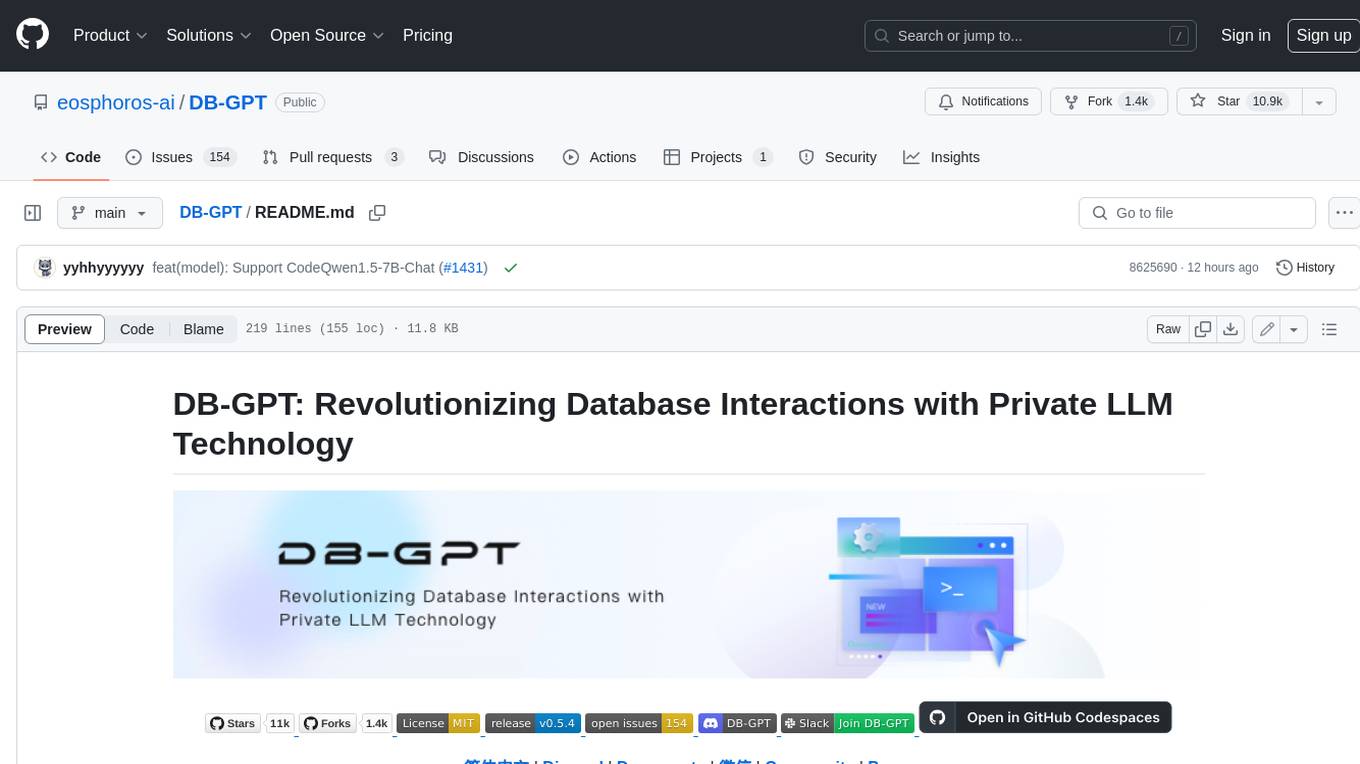
DB-GPT is an open source AI native data app development framework with AWEL(Agentic Workflow Expression Language) and agents. It aims to build infrastructure in the field of large models, through the development of multiple technical capabilities such as multi-model management (SMMF), Text2SQL effect optimization, RAG framework and optimization, Multi-Agents framework collaboration, AWEL (agent workflow orchestration), etc. Which makes large model applications with data simpler and more convenient.
README:
🤖 DB-GPT is an open source AI native data app development framework with AWEL(Agentic Workflow Expression Language) and agents.
The purpose is to build infrastructure in the field of large models, through the development of multiple technical capabilities such as multi-model management (SMMF), Text2SQL effect optimization, RAG framework and optimization, Multi-Agents framework collaboration, AWEL (agent workflow orchestration), etc. Which makes large model applications with data simpler and more convenient.
🚀 In the Data 3.0 era, based on models and databases, enterprises and developers can build their own bespoke applications with less code.
The architecture of DB-GPT is shown in the following figure:
The core capabilities include the following parts:
-
RAG (Retrieval Augmented Generation): RAG is currently the most practically implemented and urgently needed domain. DB-GPT has already implemented a framework based on RAG, allowing users to build knowledge-based applications using the RAG capabilities of DB-GPT.
-
GBI (Generative Business Intelligence): Generative BI is one of the core capabilities of the DB-GPT project, providing the foundational data intelligence technology to build enterprise report analysis and business insights.
-
Fine-tuning Framework: Model fine-tuning is an indispensable capability for any enterprise to implement in vertical and niche domains. DB-GPT provides a complete fine-tuning framework that integrates seamlessly with the DB-GPT project. In recent fine-tuning efforts, an accuracy rate based on the Spider dataset has been achieved at 82.5%.
-
Data-Driven Multi-Agents Framework: DB-GPT offers a data-driven self-evolving multi-agents framework, aiming to continuously make decisions and execute based on data.
-
Data Factory: The Data Factory is mainly about cleaning and processing trustworthy knowledge and data in the era of large models.
-
Data Sources: Integrating various data sources to seamlessly connect production business data to the core capabilities of DB-GPT.
-
DB-GPT-Hub Text-to-SQL workflow with high performance by applying Supervised Fine-Tuning (SFT) on Large Language Models (LLMs).
-
dbgpts dbgpts is the official repository which contains some data apps、AWEL operators、AWEL workflow templates and agents which build upon DB-GPT.
| LLM | Supported |
|---|---|
| LLaMA | ✅ |
| LLaMA-2 | ✅ |
| BLOOM | ✅ |
| BLOOMZ | ✅ |
| Falcon | ✅ |
| Baichuan | ✅ |
| Baichuan2 | ✅ |
| InternLM | ✅ |
| Qwen | ✅ |
| XVERSE | ✅ |
| ChatGLM2 | ✅ |
More Information about Text2SQL finetune
- DB-GPT-Plugins DB-GPT Plugins that can run Auto-GPT plugin directly
- GPT-Vis Visualization protocol
At present, we have introduced several key features to showcase our current capabilities:
-
Private Domain Q&A & Data Processing
The DB-GPT project offers a range of functionalities designed to improve knowledge base construction and enable efficient storage and retrieval of both structured and unstructured data. These functionalities include built-in support for uploading multiple file formats, the ability to integrate custom data extraction plug-ins, and unified vector storage and retrieval capabilities for effectively managing large volumes of information.
-
Multi-Data Source & GBI(Generative Business intelligence)
The DB-GPT project facilitates seamless natural language interaction with diverse data sources, including Excel, databases, and data warehouses. It simplifies the process of querying and retrieving information from these sources, empowering users to engage in intuitive conversations and gain insights. Moreover, DB-GPT supports the generation of analytical reports, providing users with valuable data summaries and interpretations.
-
Multi-Agents&Plugins
It offers support for custom plug-ins to perform various tasks and natively integrates the Auto-GPT plug-in model. The Agents protocol adheres to the Agent Protocol standard.
-
Automated Fine-tuning text2SQL
We've also developed an automated fine-tuning lightweight framework centred on large language models (LLMs), Text2SQL datasets, LoRA/QLoRA/Pturning, and other fine-tuning methods. This framework simplifies Text-to-SQL fine-tuning, making it as straightforward as an assembly line process. DB-GPT-Hub
-
SMMF(Service-oriented Multi-model Management Framework)
We offer extensive model support, including dozens of large language models (LLMs) from both open-source and API agents, such as LLaMA/LLaMA2, Baichuan, ChatGLM, Wenxin, Tongyi, Zhipu, and many more.
-
News
Provider Supported Models DeepSeek ✅ 🔥🔥🔥 DeepSeek-R1-0528
🔥🔥🔥 DeepSeek-V3-0324
🔥🔥🔥 DeepSeek-R1
🔥🔥🔥 DeepSeek-V3
🔥🔥🔥 DeepSeek-R1-Distill-Llama-70B
🔥🔥🔥 DeepSeek-R1-Distill-Qwen-32B
🔥🔥🔥 DeepSeek-Coder-V2-Instruct
Qwen ✅ 🔥🔥🔥 Qwen3-235B-A22B
🔥🔥🔥 Qwen3-30B-A3B
🔥🔥🔥 Qwen3-32B
🔥🔥🔥 QwQ-32B
🔥🔥🔥 Qwen2.5-Coder-32B-Instruct
🔥🔥🔥 Qwen2.5-Coder-14B-Instruct
🔥🔥🔥 Qwen2.5-72B-Instruct
🔥🔥🔥 Qwen2.5-32B-Instruct
GLM ✅ 🔥🔥🔥 GLM-Z1-32B-0414
🔥🔥🔥 GLM-4-32B-0414
🔥🔥🔥 Glm-4-9b-chatLlama ✅ 🔥🔥🔥 Meta-Llama-3.1-405B-Instruct
🔥🔥🔥 Meta-Llama-3.1-70B-Instruct
🔥🔥🔥 Meta-Llama-3.1-8B-Instruct
🔥🔥🔥 Meta-Llama-3-70B-Instruct
🔥🔥🔥 Meta-Llama-3-8B-InstructGemma ✅ 🔥🔥🔥 gemma-2-27b-it
🔥🔥🔥 gemma-2-9b-it
🔥🔥🔥 gemma-7b-it
🔥🔥🔥 gemma-2b-itYi ✅ 🔥🔥🔥 Yi-1.5-34B-Chat
🔥🔥🔥 Yi-1.5-9B-Chat
🔥🔥🔥 Yi-1.5-6B-Chat
🔥🔥🔥 Yi-34B-ChatStarling ✅ 🔥🔥🔥 Starling-LM-7B-beta SOLAR ✅ 🔥🔥🔥 SOLAR-10.7B Mixtral ✅ 🔥🔥🔥 Mixtral-8x7B Phi ✅ 🔥🔥🔥 Phi-3
-
-
Privacy and Security
We ensure the privacy and security of data through the implementation of various technologies, including privatized large models and proxy desensitization.
-
Support Datasources
- To check detailed guidelines for new contributions, please refer how to contribute
The MIT License (MIT)
If you want to understand the overall architecture of DB-GPT, please cite Paper and Paper
If you want to learn about using DB-GPT for Agent development, please cite the Paper
@article{xue2023dbgpt,
title={DB-GPT: Empowering Database Interactions with Private Large Language Models},
author={Siqiao Xue and Caigao Jiang and Wenhui Shi and Fangyin Cheng and Keting Chen and Hongjun Yang and Zhiping Zhang and Jianshan He and Hongyang Zhang and Ganglin Wei and Wang Zhao and Fan Zhou and Danrui Qi and Hong Yi and Shaodong Liu and Faqiang Chen},
year={2023},
journal={arXiv preprint arXiv:2312.17449},
url={https://arxiv.org/abs/2312.17449}
}
@misc{huang2024romasrolebasedmultiagentdatabase,
title={ROMAS: A Role-Based Multi-Agent System for Database monitoring and Planning},
author={Yi Huang and Fangyin Cheng and Fan Zhou and Jiahui Li and Jian Gong and Hongjun Yang and Zhidong Fan and Caigao Jiang and Siqiao Xue and Faqiang Chen},
year={2024},
eprint={2412.13520},
archivePrefix={arXiv},
primaryClass={cs.AI},
url={https://arxiv.org/abs/2412.13520},
}
@inproceedings{xue2024demonstration,
title={Demonstration of DB-GPT: Next Generation Data Interaction System Empowered by Large Language Models},
author={Siqiao Xue and Danrui Qi and Caigao Jiang and Wenhui Shi and Fangyin Cheng and Keting Chen and Hongjun Yang and Zhiping Zhang and Jianshan He and Hongyang Zhang and Ganglin Wei and Wang Zhao and Fan Zhou and Hong Yi and Shaodong Liu and Hongjun Yang and Faqiang Chen},
year={2024},
booktitle = "Proceedings of the VLDB Endowment",
url={https://arxiv.org/abs/2404.10209}
}Thanks to everyone who has contributed to DB-GPT! Your ideas, code, comments, and even sharing them at events and on social platforms can make DB-GPT better. We are working on building a community, if you have any ideas for building the community, feel free to contact us.
- Github Issues ⭐️:For questions about using GB-DPT, see the CONTRIBUTING.
- Github Discussions ⭐️:Share your experience or unique apps.
- Twitter ⭐️:Please feel free to talk to us.
For Tasks:
Click tags to check more tools for each tasksFor Jobs:
Alternative AI tools for DB-GPT
Similar Open Source Tools

DB-GPT
DB-GPT is an open source AI native data app development framework with AWEL(Agentic Workflow Expression Language) and agents. It aims to build infrastructure in the field of large models, through the development of multiple technical capabilities such as multi-model management (SMMF), Text2SQL effect optimization, RAG framework and optimization, Multi-Agents framework collaboration, AWEL (agent workflow orchestration), etc. Which makes large model applications with data simpler and more convenient.
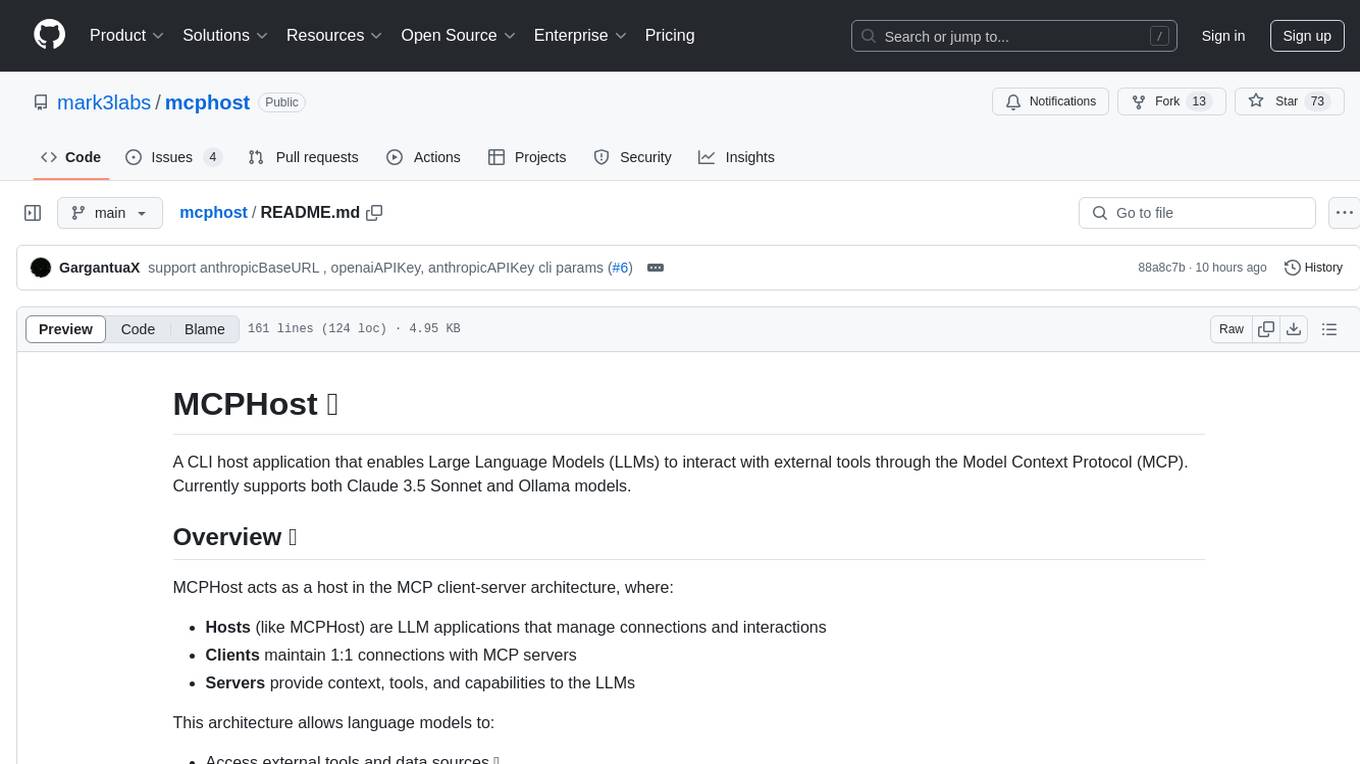
mcphost
MCPHost is a CLI host application that enables Large Language Models (LLMs) to interact with external tools through the Model Context Protocol (MCP). It acts as a host in the MCP client-server architecture, allowing language models to access external tools and data sources, maintain consistent context across interactions, and execute commands safely. The tool supports interactive conversations with Claude 3.5 Sonnet and Ollama models, multiple concurrent MCP servers, dynamic tool discovery and integration, configurable server locations and arguments, and a consistent command interface across model types.
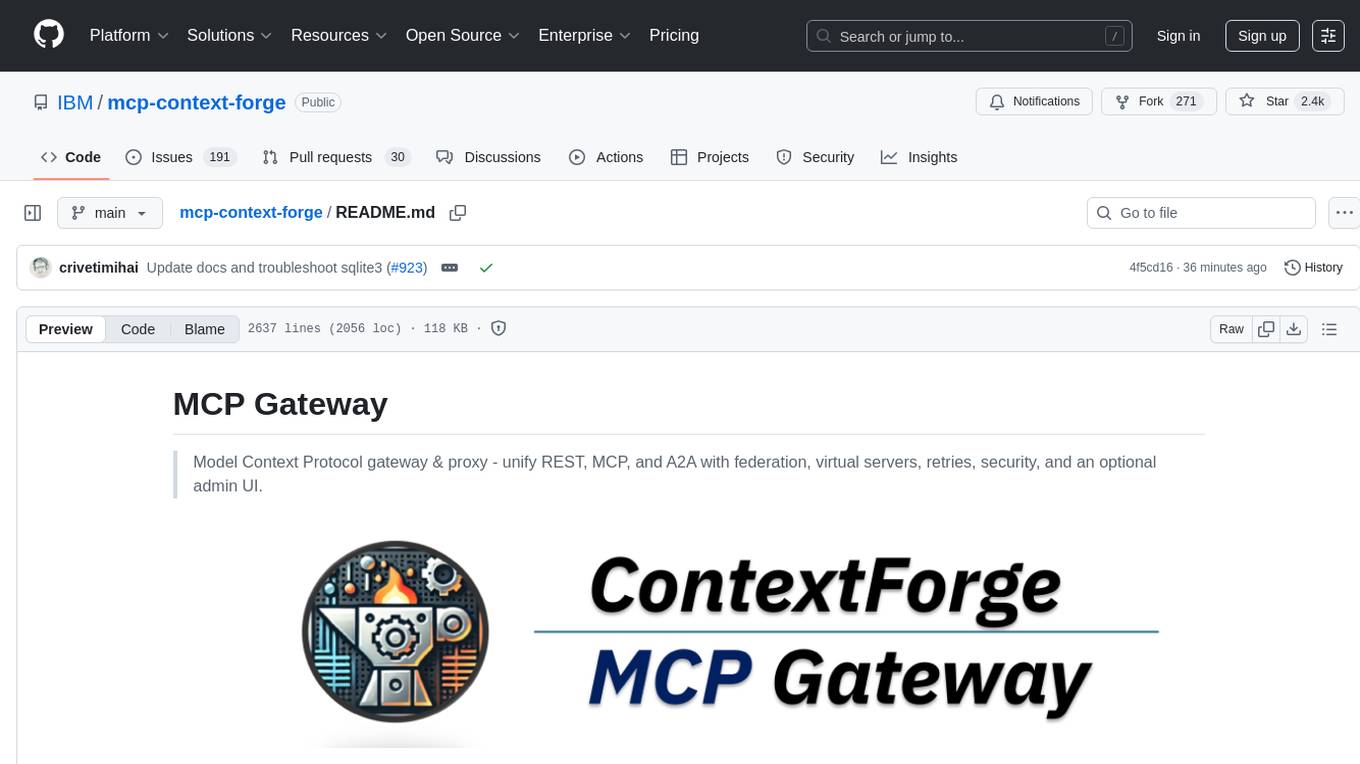
mcp-context-forge
MCP Context Forge is a powerful tool for generating context-aware data for machine learning models. It provides functionalities to create diverse datasets with contextual information, enhancing the performance of AI algorithms. The tool supports various data formats and allows users to customize the context generation process easily. With MCP Context Forge, users can efficiently prepare training data for tasks requiring contextual understanding, such as sentiment analysis, recommendation systems, and natural language processing.
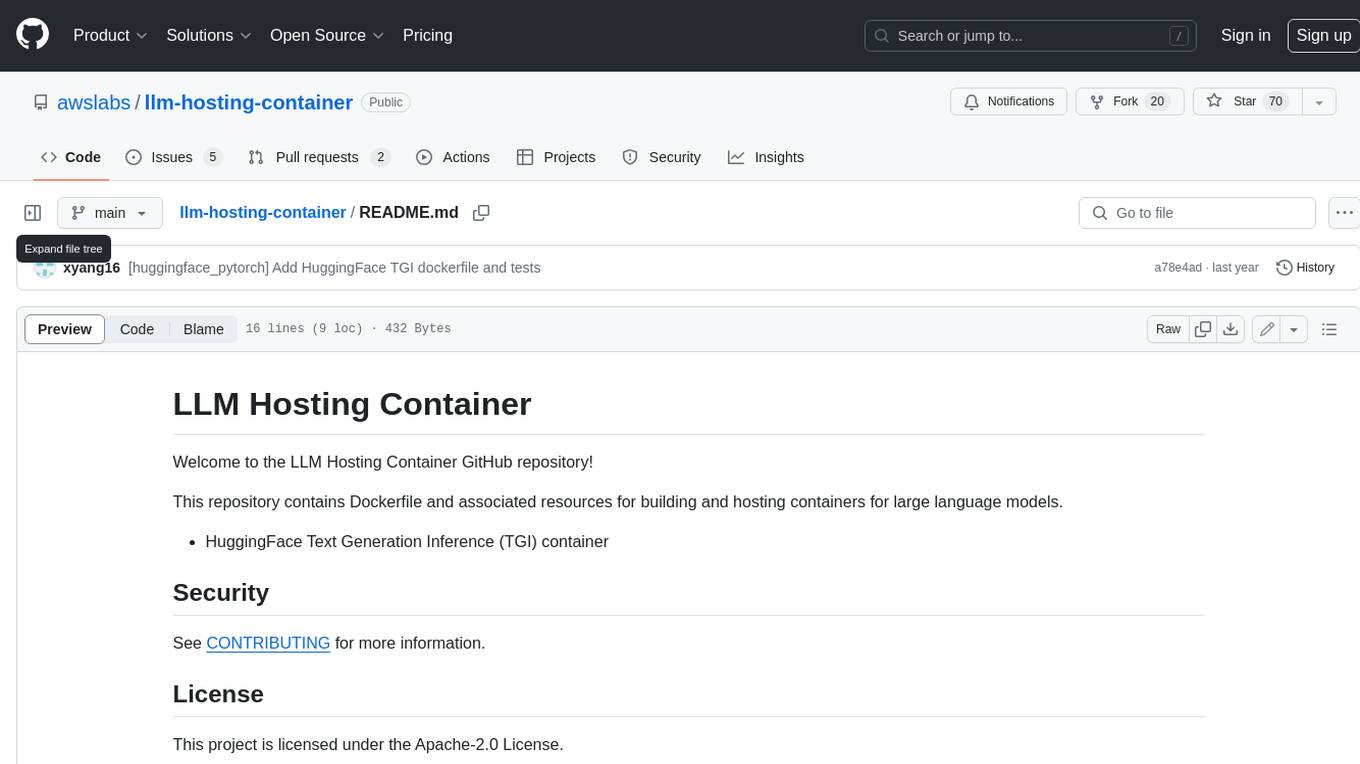
llm-hosting-container
The LLM Hosting Container repository provides Dockerfile and associated resources for building and hosting containers for large language models, specifically the HuggingFace Text Generation Inference (TGI) container. This tool allows users to easily deploy and manage large language models in a containerized environment, enabling efficient inference and deployment of language-based applications.
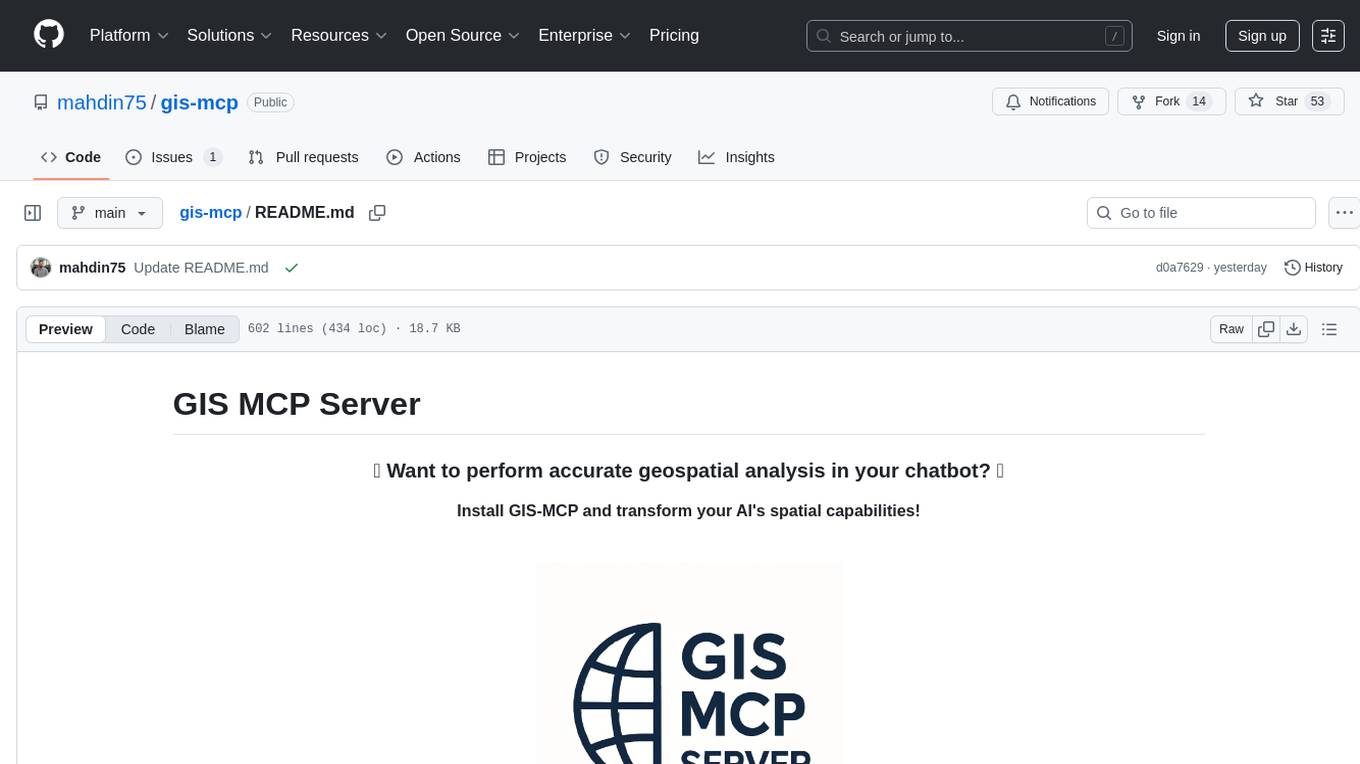
gis-mcp
This repository contains a Geographic Information System (GIS) tool for performing Minimum Cumulative Path (MCP) analysis. The tool allows users to calculate the optimal path that minimizes cumulative cost between multiple locations on a map. It is particularly useful for urban planning, transportation route optimization, and environmental impact assessment. The tool supports various cost functions such as distance, travel time, and resource consumption, providing flexibility for different applications. Users can visualize the results on interactive maps and export the analysis outputs for further processing. The tool is implemented in Python and leverages popular GIS libraries such as GeoPandas and NetworkX for efficient spatial analysis.
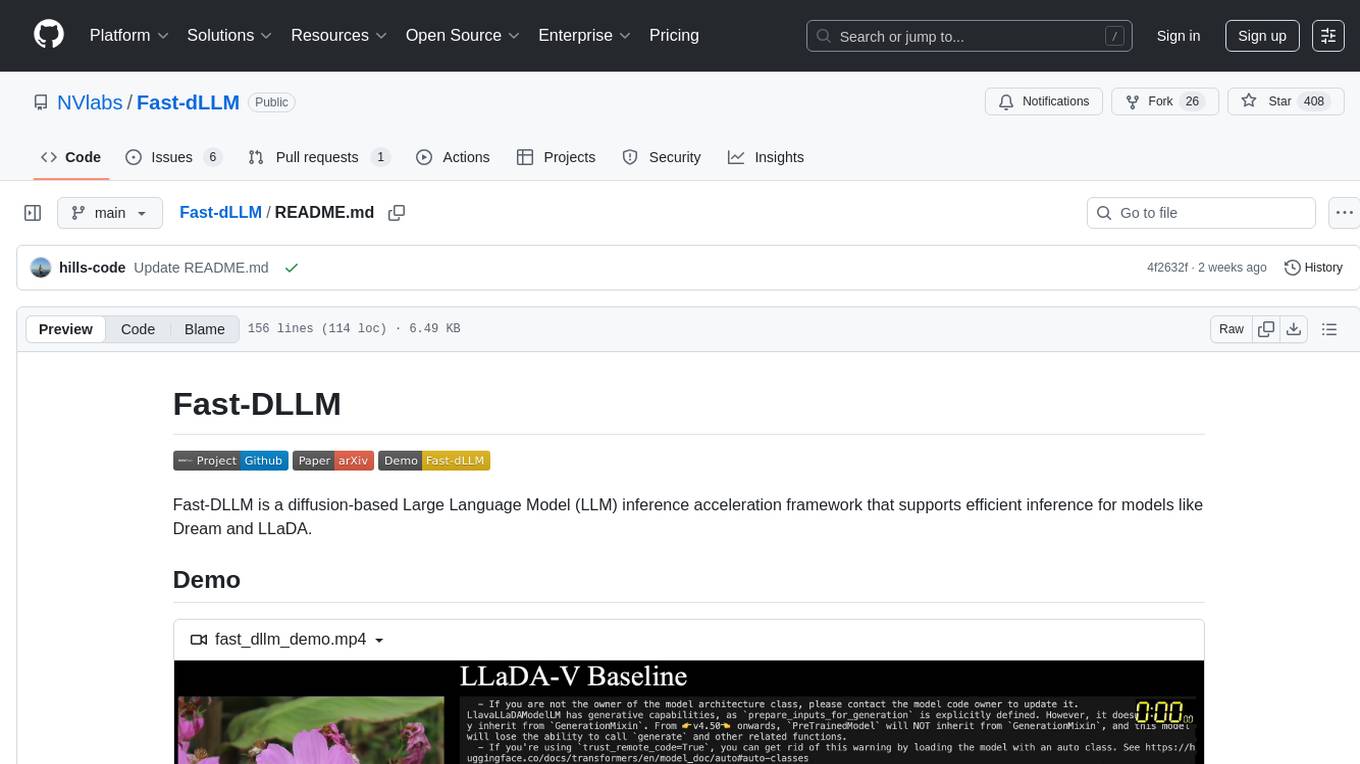
Fast-dLLM
Fast-DLLM is a diffusion-based Large Language Model (LLM) inference acceleration framework that supports efficient inference for models like Dream and LLaDA. It offers fast inference support, multiple optimization strategies, code generation, evaluation capabilities, and an interactive chat interface. Key features include Key-Value Cache for Block-Wise Decoding, Confidence-Aware Parallel Decoding, and overall performance improvements. The project structure includes directories for Dream and LLaDA model-related code, with installation and usage instructions provided for using the LLaDA and Dream models.
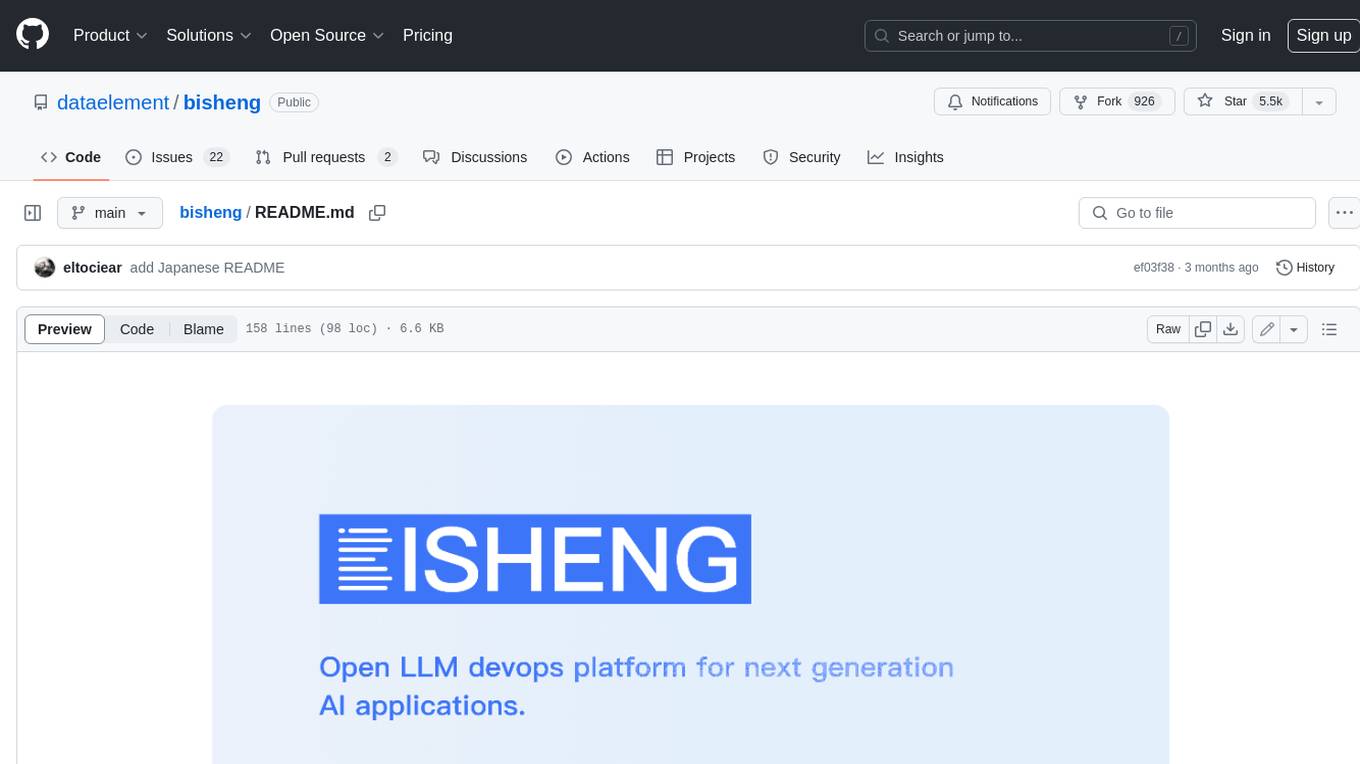
bisheng
Bisheng is a leading open-source **large model application development platform** that empowers and accelerates the development and deployment of large model applications, helping users enter the next generation of application development with the best possible experience.
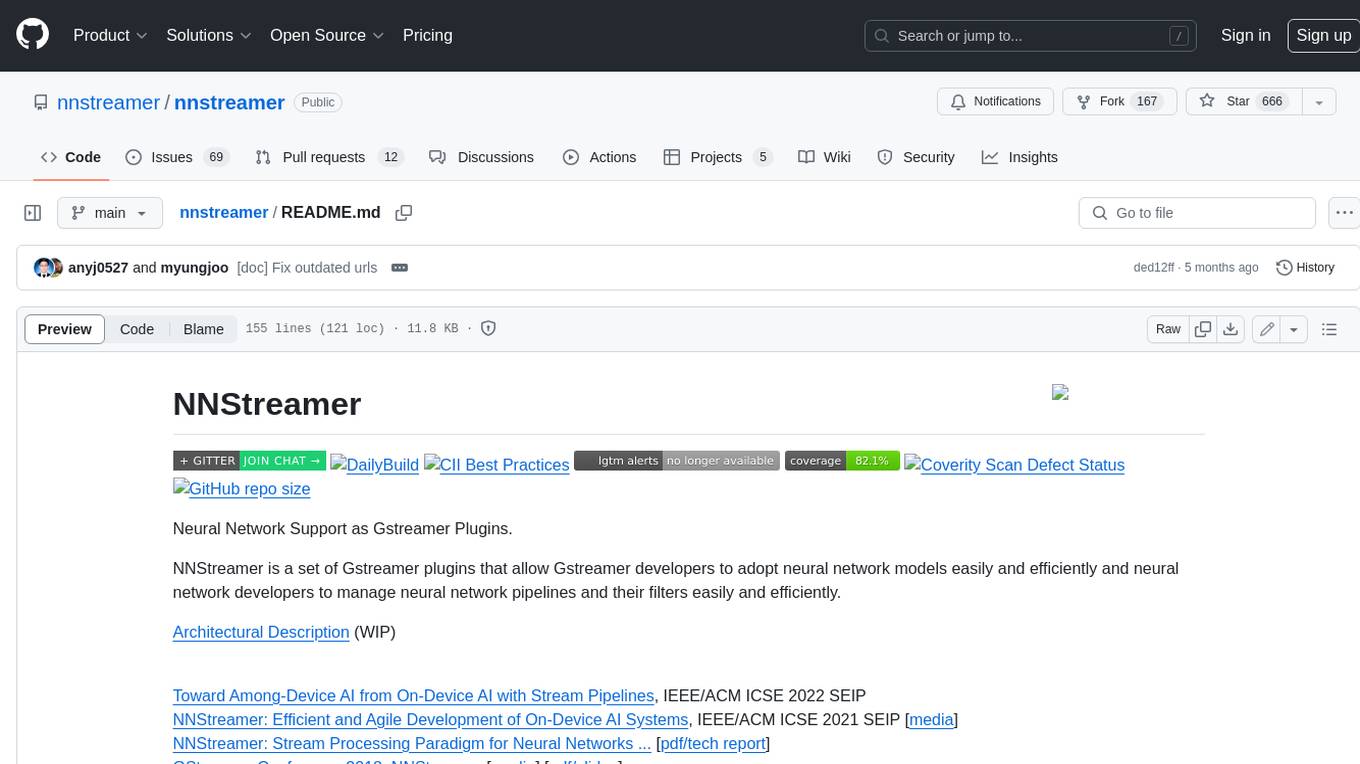
nnstreamer
NNStreamer is a set of Gstreamer plugins that allow Gstreamer developers to adopt neural network models easily and efficiently and neural network developers to manage neural network pipelines and their filters easily and efficiently.
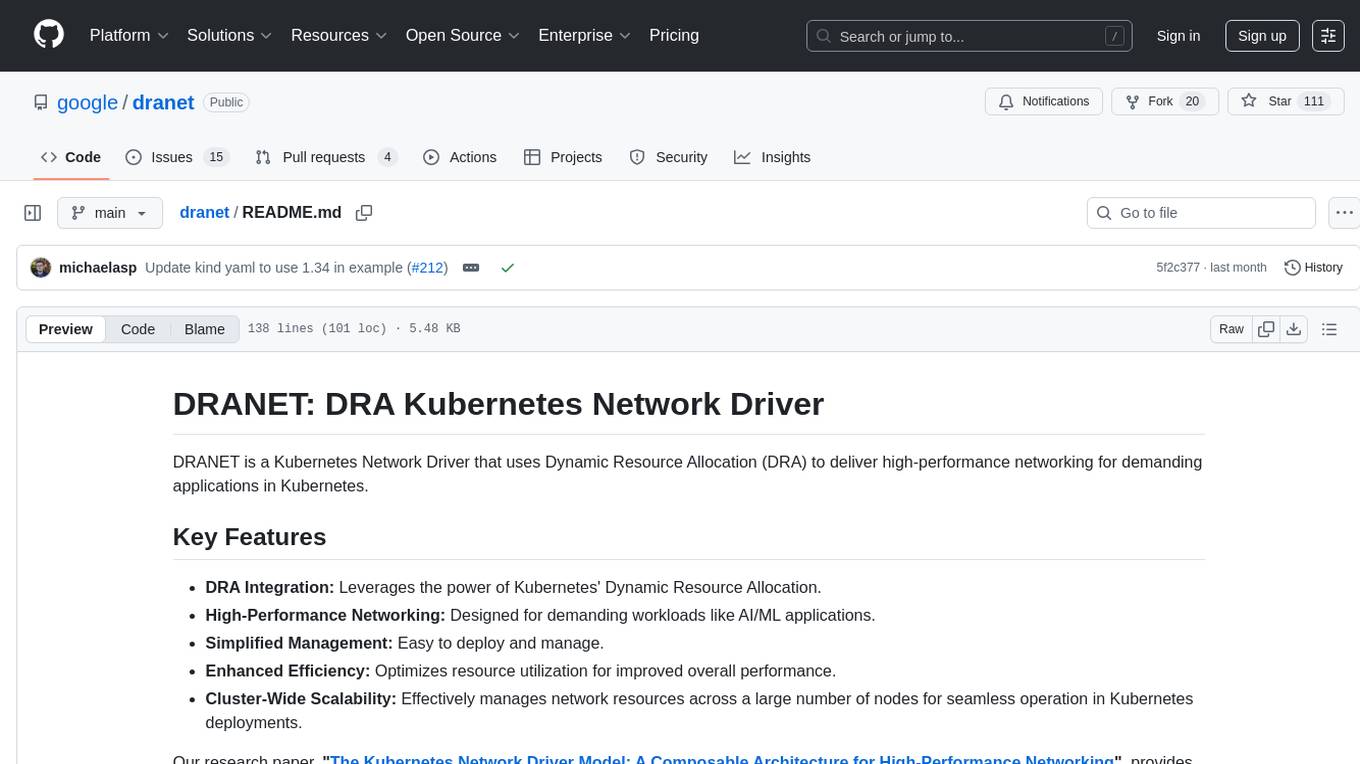
dranet
Dranet is a Python library for analyzing and visualizing data from neural networks. It provides tools for interpreting model predictions, understanding feature importance, and evaluating model performance. With Dranet, users can gain insights into how neural networks make decisions and improve model transparency and interpretability.
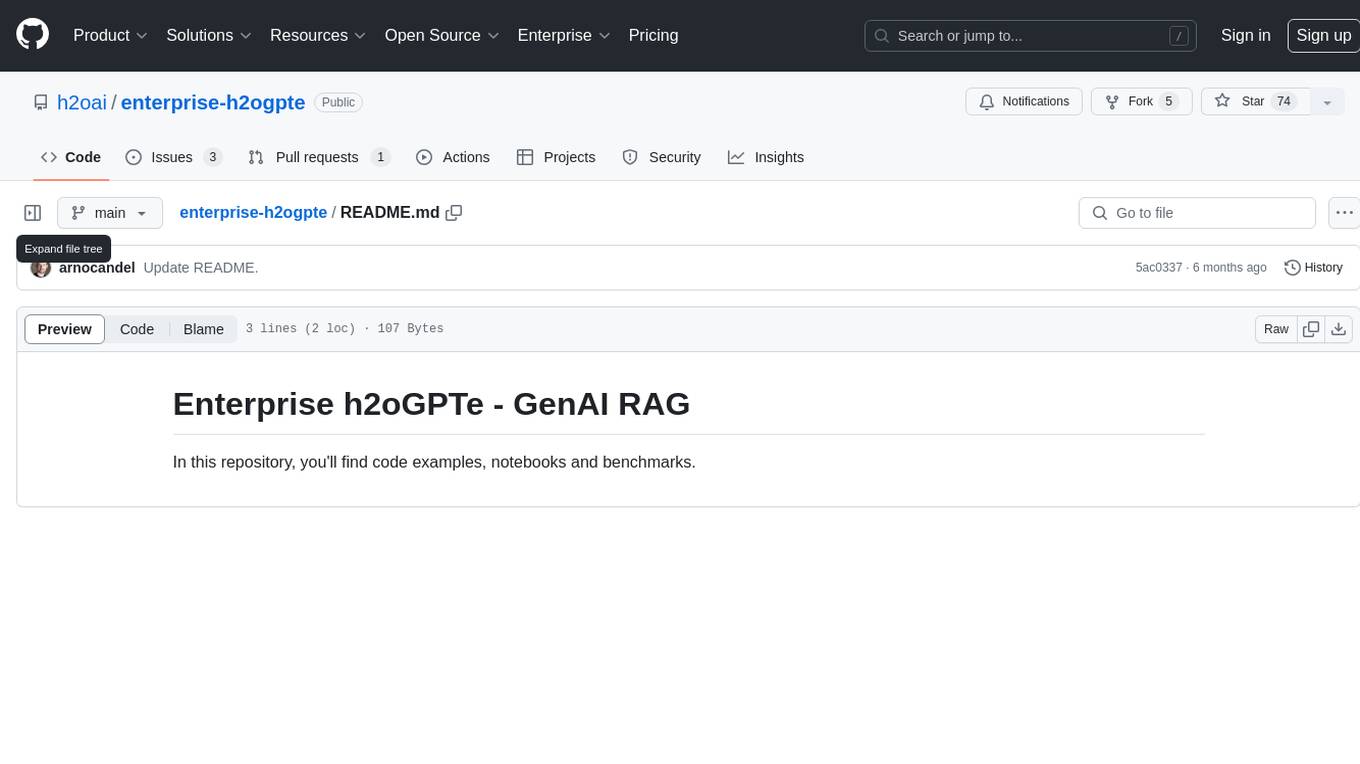
enterprise-h2ogpte
Enterprise h2oGPTe - GenAI RAG is a repository containing code examples, notebooks, and benchmarks for the enterprise version of h2oGPTe, a powerful AI tool for generating text based on the RAG (Retrieval-Augmented Generation) architecture. The repository provides resources for leveraging h2oGPTe in enterprise settings, including implementation guides, performance evaluations, and best practices. Users can explore various applications of h2oGPTe in natural language processing tasks, such as text generation, content creation, and conversational AI.
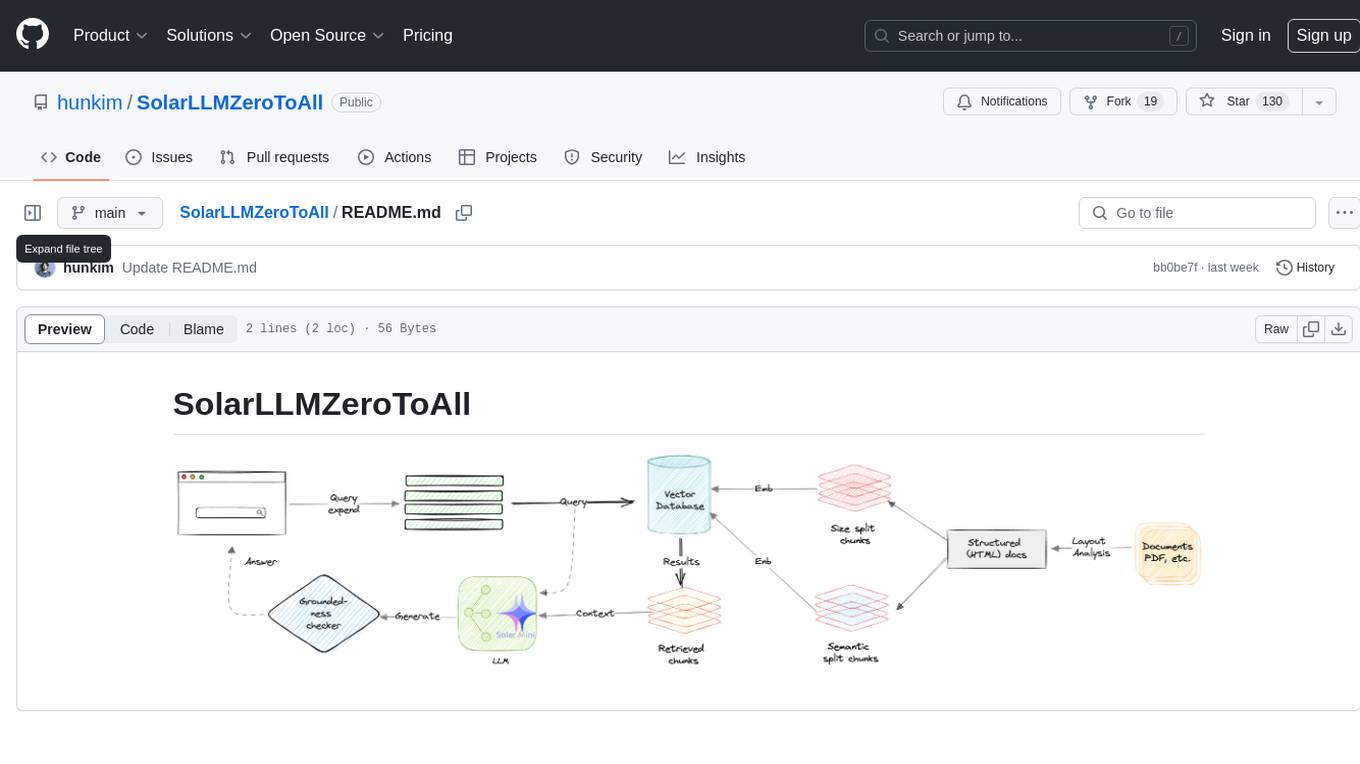
SolarLLMZeroToAll
SolarLLMZeroToAll is a comprehensive repository that provides a step-by-step guide and resources for learning and implementing Solar Longitudinal Learning Machines (SolarLLM) from scratch. The repository covers various aspects of SolarLLM, including theory, implementation, and applications, making it suitable for beginners and advanced users interested in solar energy forecasting and machine learning. The materials include detailed explanations, code examples, datasets, and visualization tools to facilitate understanding and practical implementation of SolarLLM models.
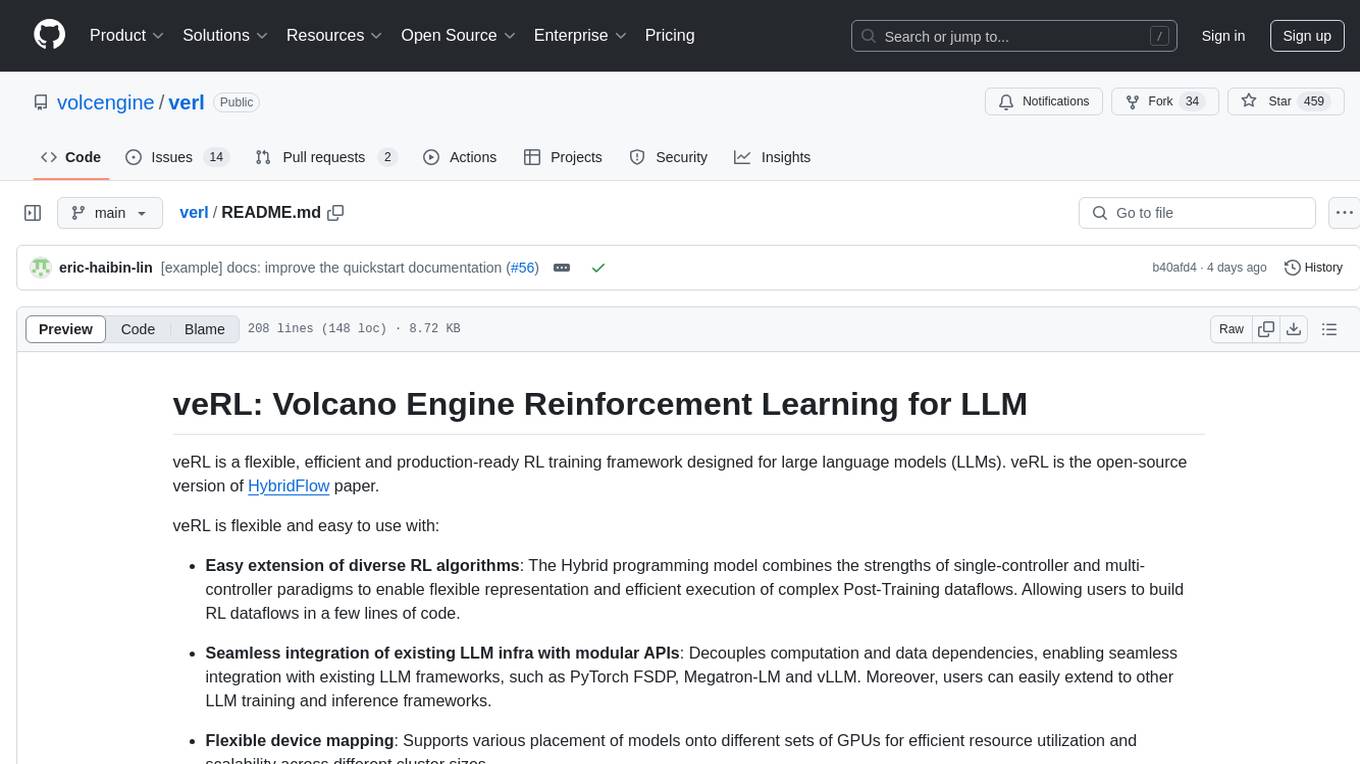
verl
veRL is a flexible and efficient reinforcement learning training framework designed for large language models (LLMs). It allows easy extension of diverse RL algorithms, seamless integration with existing LLM infrastructures, and flexible device mapping. The framework achieves state-of-the-art throughput and efficient actor model resharding with 3D-HybridEngine. It supports popular HuggingFace models and is suitable for users working with PyTorch FSDP, Megatron-LM, and vLLM backends.
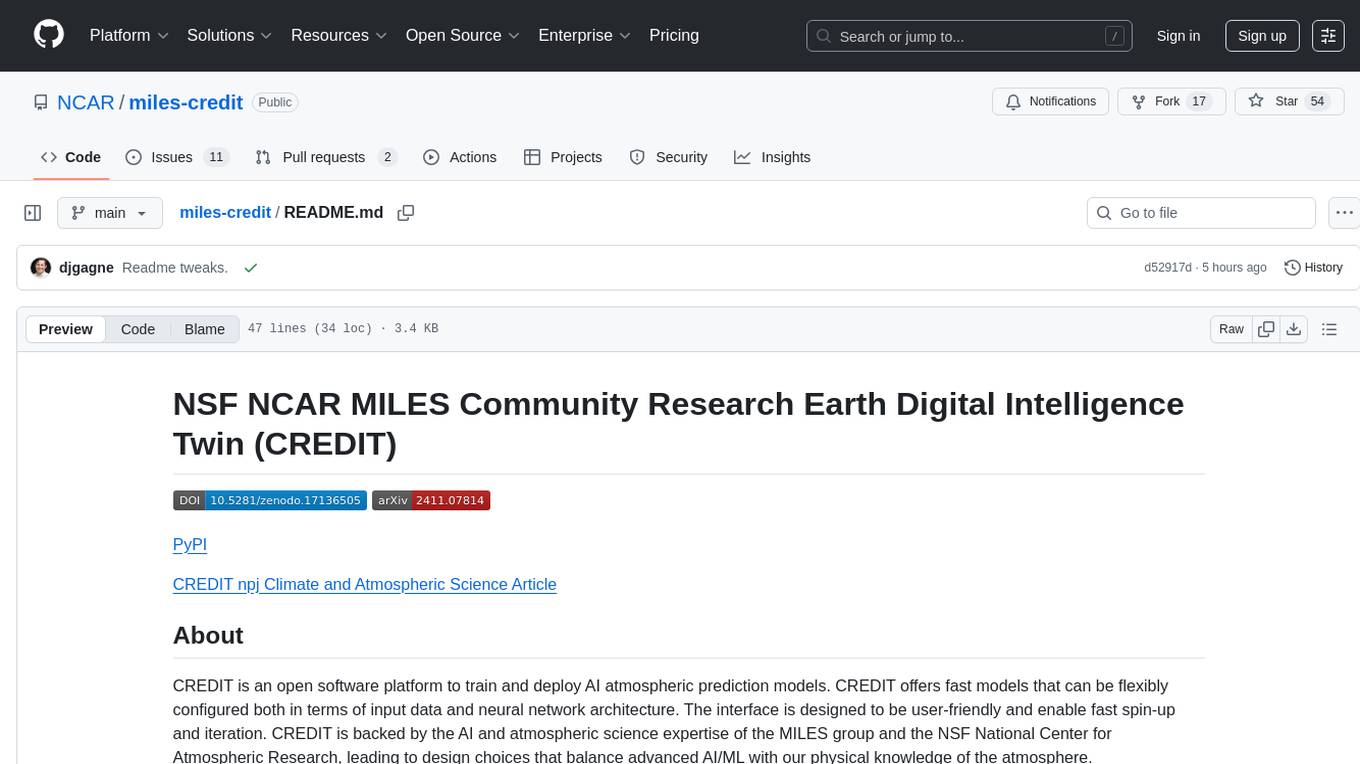
miles-credit
CREDIT is an open software platform for training and deploying AI atmospheric prediction models. It offers fast models with flexible configuration options for input data and neural network architecture. The user-friendly interface enables quick setup and iteration. Developed by the MILES group and NSF National Center for Atmospheric Research, CREDIT combines advanced AI/ML with atmospheric science expertise. It provides a stable release with various models, training, and deployment options, with ongoing development. Detailed documentation is available for installation, training, deployment, config file interpretation, and API usage.
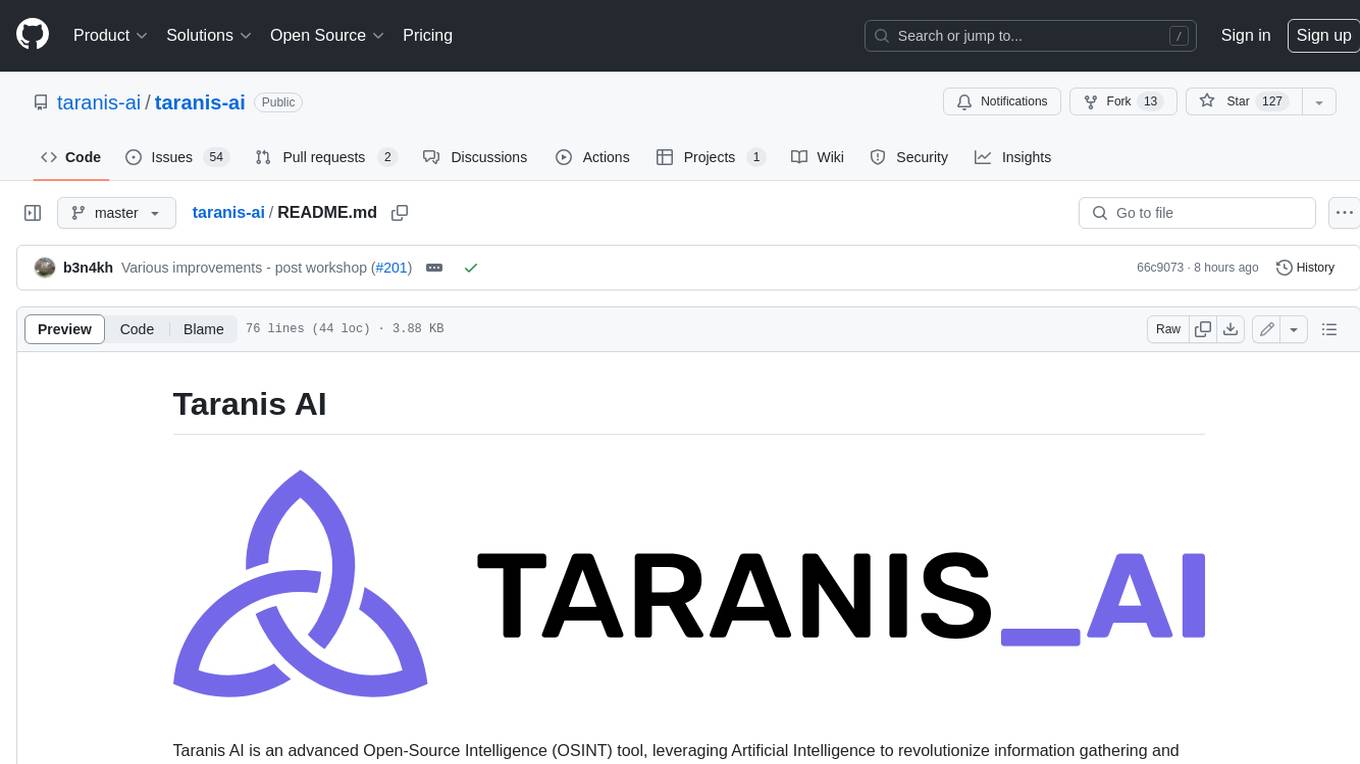
taranis-ai
Taranis AI is an advanced Open-Source Intelligence (OSINT) tool that leverages Artificial Intelligence to revolutionize information gathering and situational analysis. It navigates through diverse data sources like websites to collect unstructured news articles, utilizing Natural Language Processing and Artificial Intelligence to enhance content quality. Analysts then refine these AI-augmented articles into structured reports that serve as the foundation for deliverables such as PDF files, which are ultimately published.
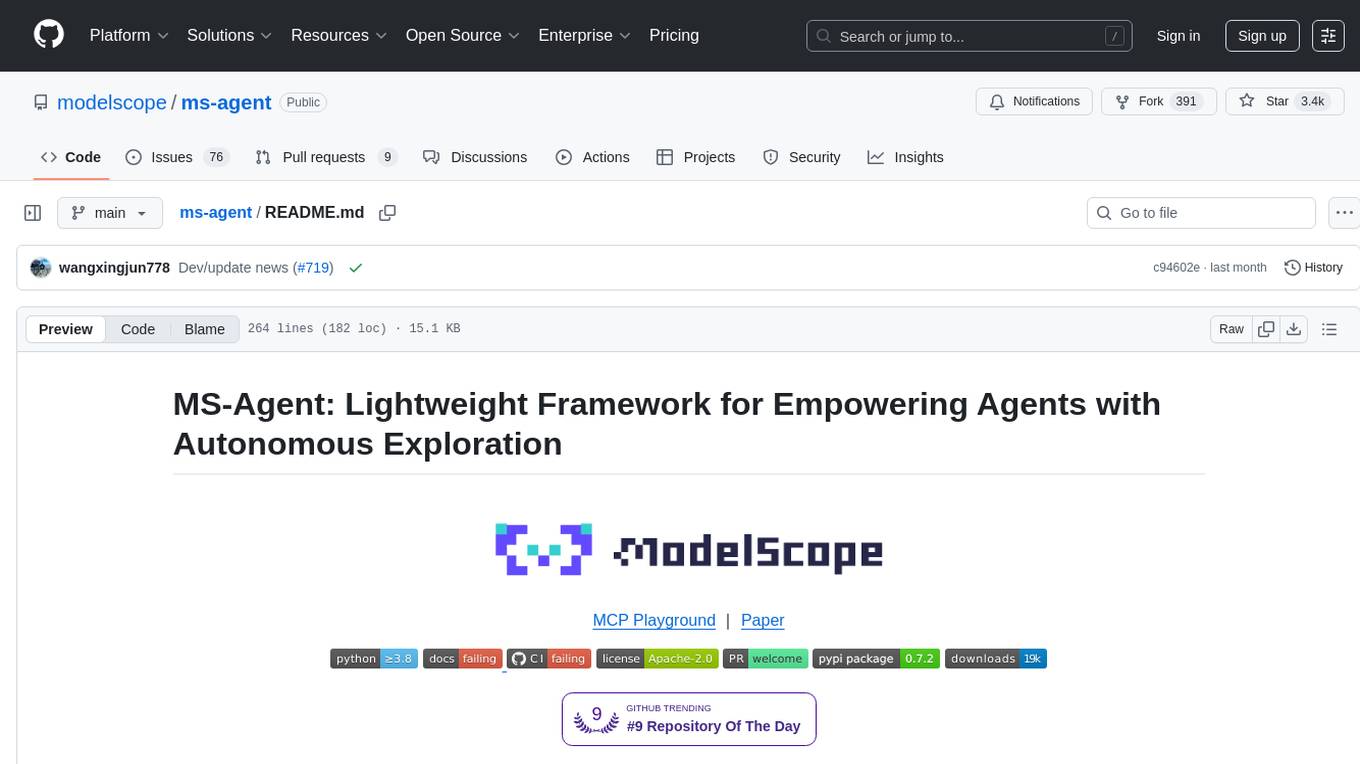
ms-agent
MS-Agent is a lightweight framework designed to empower agents with autonomous exploration capabilities. It provides a flexible and extensible architecture for creating agents capable of tasks like code generation, data analysis, and tool calling with MCP support. The framework supports multi-agent interactions, deep research, code generation, and is lightweight and extensible for various applications.
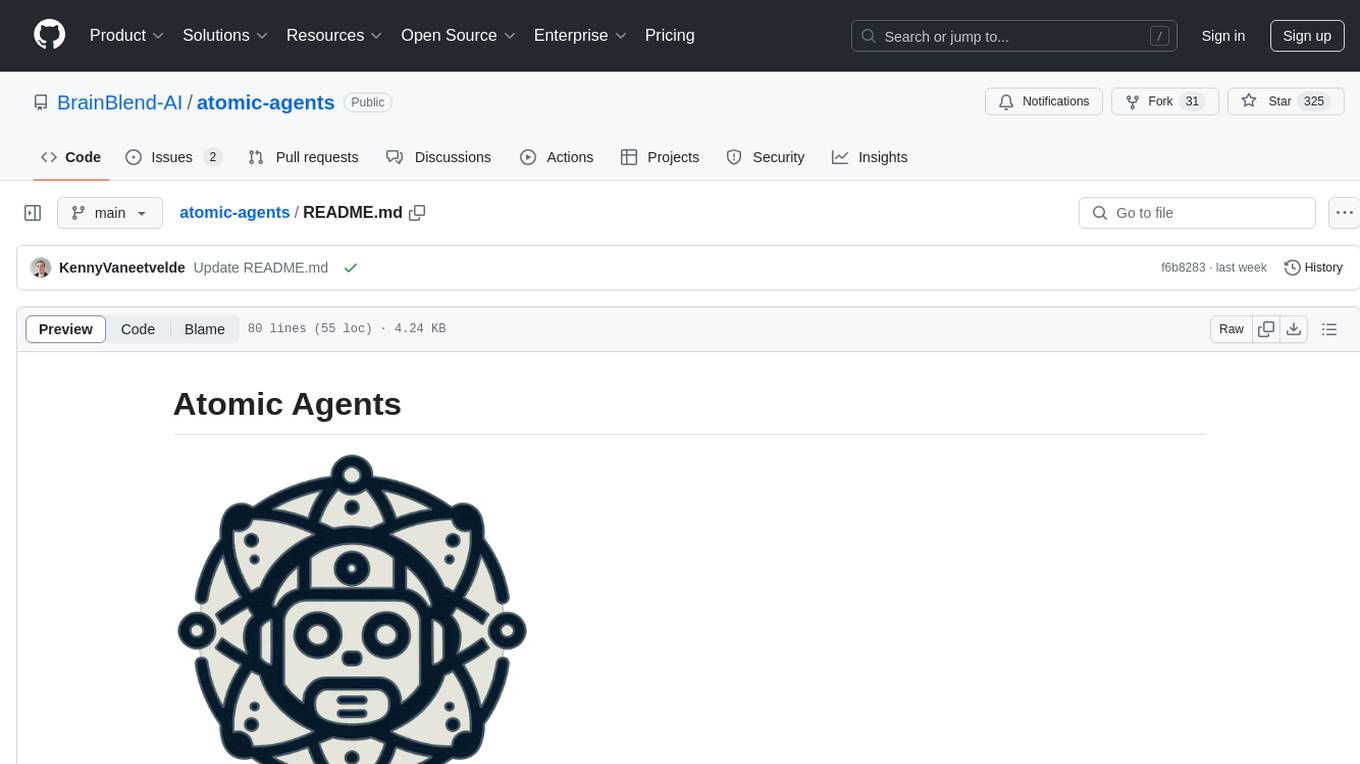
atomic-agents
The Atomic Agents framework is a modular and extensible tool designed for creating powerful applications. It leverages Pydantic for data validation and serialization. The framework follows the principles of Atomic Design, providing small and single-purpose components that can be combined. It integrates with Instructor for AI agent architecture and supports various APIs like Cohere, Anthropic, and Gemini. The tool includes documentation, examples, and testing features to ensure smooth development and usage.
For similar tasks

DB-GPT
DB-GPT is an open source AI native data app development framework with AWEL(Agentic Workflow Expression Language) and agents. It aims to build infrastructure in the field of large models, through the development of multiple technical capabilities such as multi-model management (SMMF), Text2SQL effect optimization, RAG framework and optimization, Multi-Agents framework collaboration, AWEL (agent workflow orchestration), etc. Which makes large model applications with data simpler and more convenient.
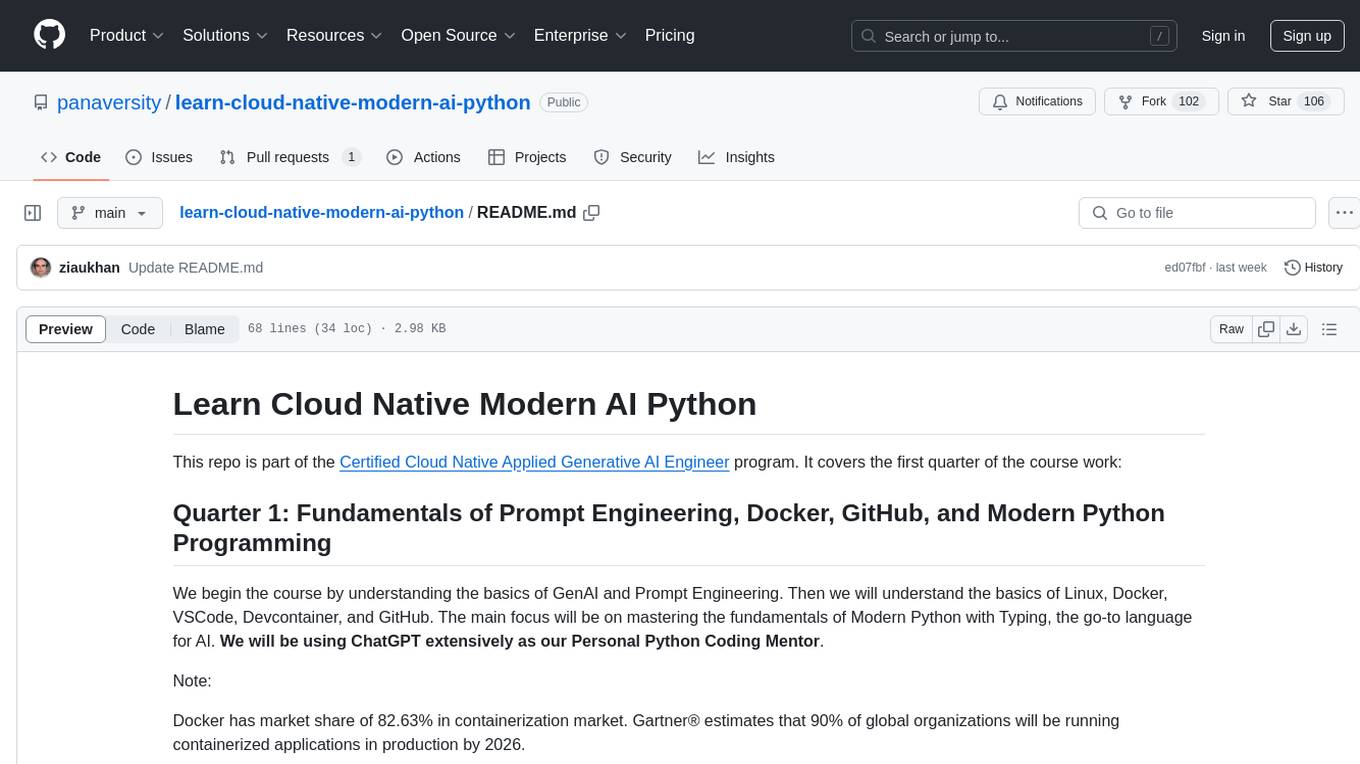
learn-cloud-native-modern-ai-python
This repository is part of the Certified Cloud Native Applied Generative AI Engineer program, focusing on the fundamentals of Prompt Engineering, Docker, GitHub, and Modern Python Programming. It covers the basics of GenAI, Linux, Docker, VSCode, Devcontainer, and GitHub. The main emphasis is on mastering Modern Python with Typing, using ChatGPT as a Personal Python Coding Mentor. The course material includes tools installation, study materials, and projects related to Python development in Docker containers and GitHub usage.
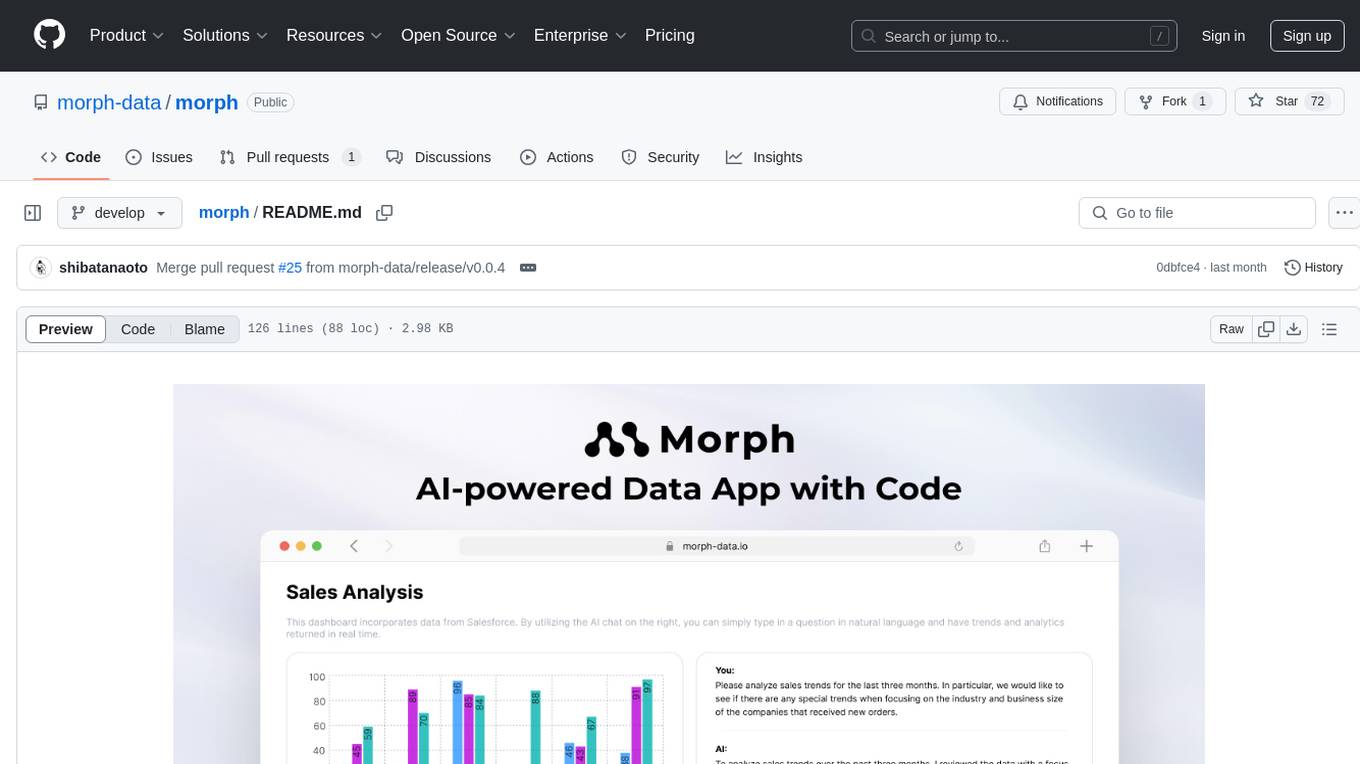
morph
Morph is a python-centric full-stack framework for building and deploying data apps. It is fast to start, deploy and operate, requires no HTML/CSS knowledge, and is customizable with Python and SQL for advanced data workflows. With Markdown-based syntax and pre-made components, users can create visually appealing designs without writing HTML or CSS.
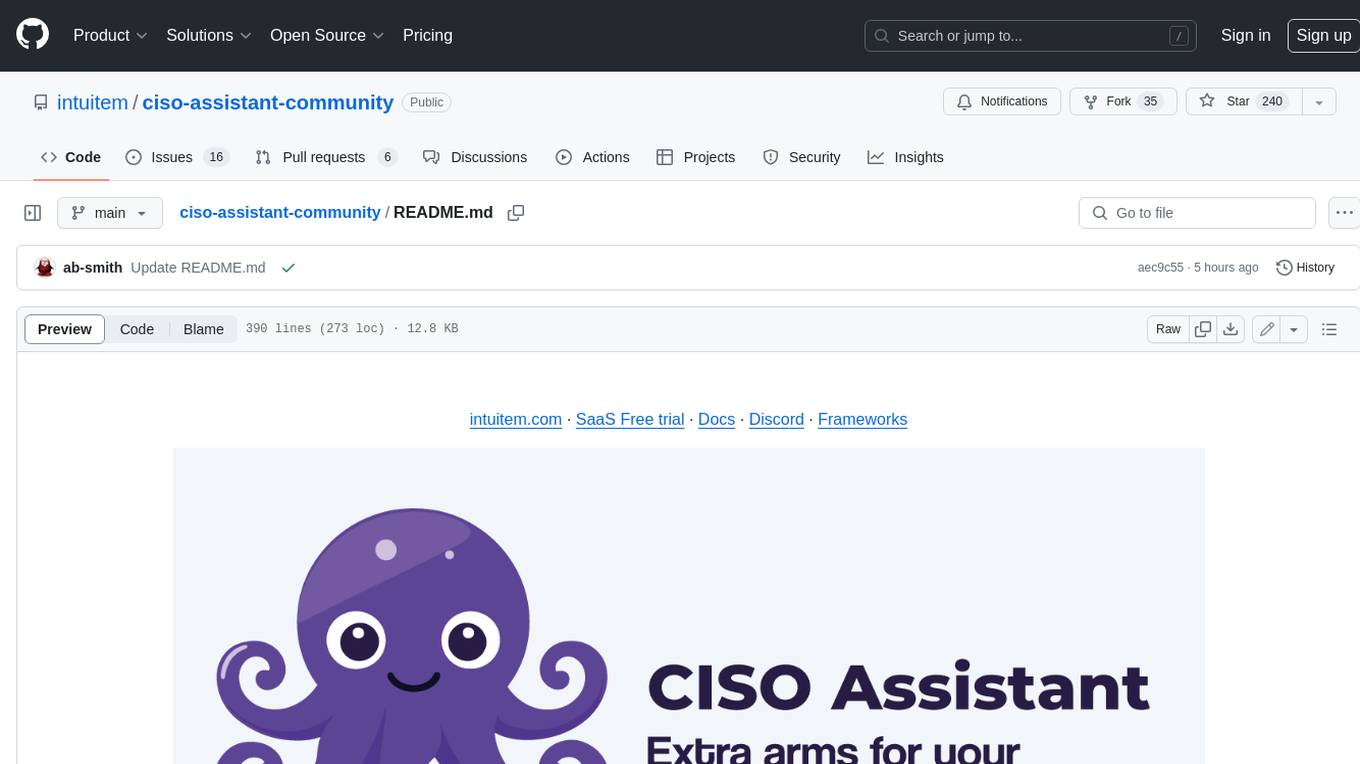
ciso-assistant-community
CISO Assistant is a tool that helps organizations manage their cybersecurity posture and compliance. It provides a centralized platform for managing security controls, threats, and risks. CISO Assistant also includes a library of pre-built frameworks and tools to help organizations quickly and easily implement best practices.
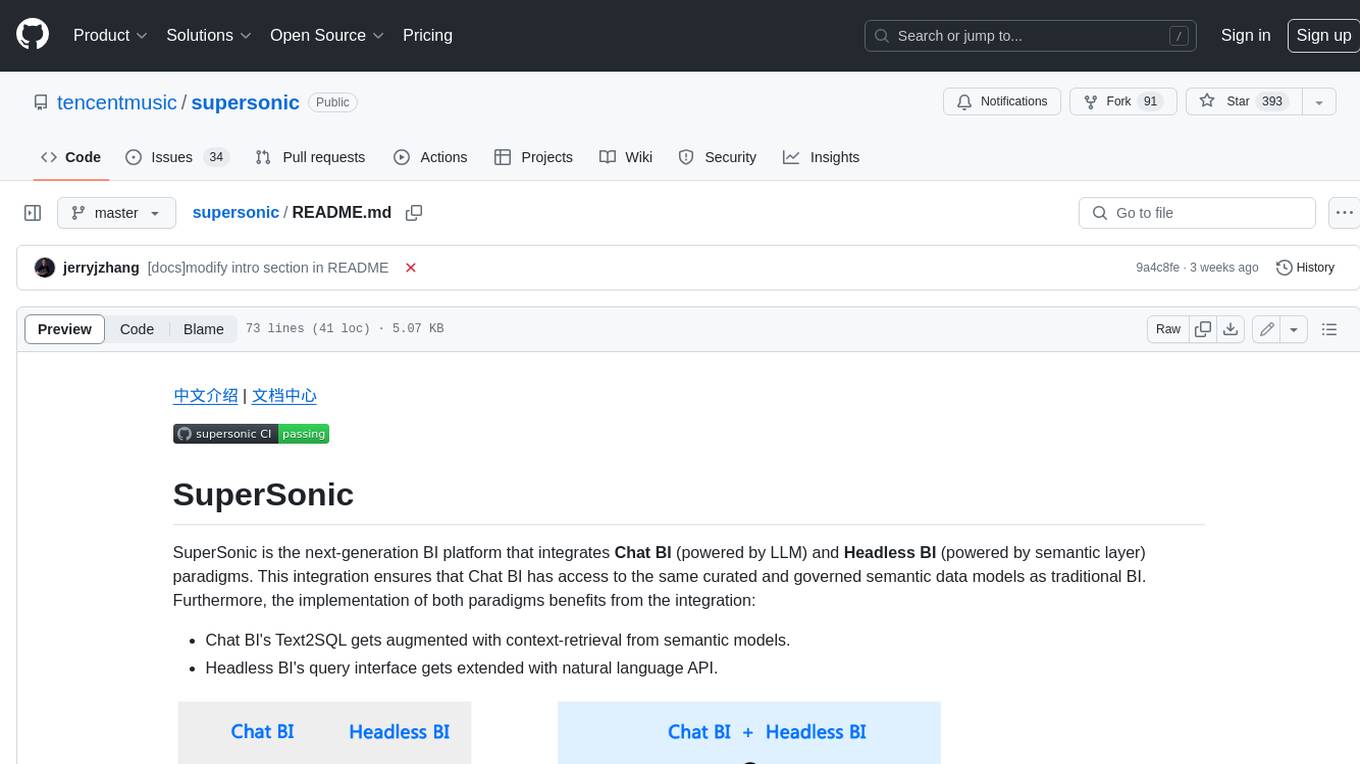
supersonic
SuperSonic is a next-generation BI platform that integrates Chat BI (powered by LLM) and Headless BI (powered by semantic layer) paradigms. This integration ensures that Chat BI has access to the same curated and governed semantic data models as traditional BI. Furthermore, the implementation of both paradigms benefits from the integration: * Chat BI's Text2SQL gets augmented with context-retrieval from semantic models. * Headless BI's query interface gets extended with natural language API. SuperSonic provides a Chat BI interface that empowers users to query data using natural language and visualize the results with suitable charts. To enable such experience, the only thing necessary is to build logical semantic models (definition of metric/dimension/tag, along with their meaning and relationships) through a Headless BI interface. Meanwhile, SuperSonic is designed to be extensible and composable, allowing custom implementations to be added and configured with Java SPI. The integration of Chat BI and Headless BI has the potential to enhance the Text2SQL generation in two dimensions: 1. Incorporate data semantics (such as business terms, column values, etc.) into the prompt, enabling LLM to better understand the semantics and reduce hallucination. 2. Offload the generation of advanced SQL syntax (such as join, formula, etc.) from LLM to the semantic layer to reduce complexity. With these ideas in mind, we develop SuperSonic as a practical reference implementation and use it to power our real-world products. Additionally, to facilitate further development we decide to open source SuperSonic as an extensible framework.
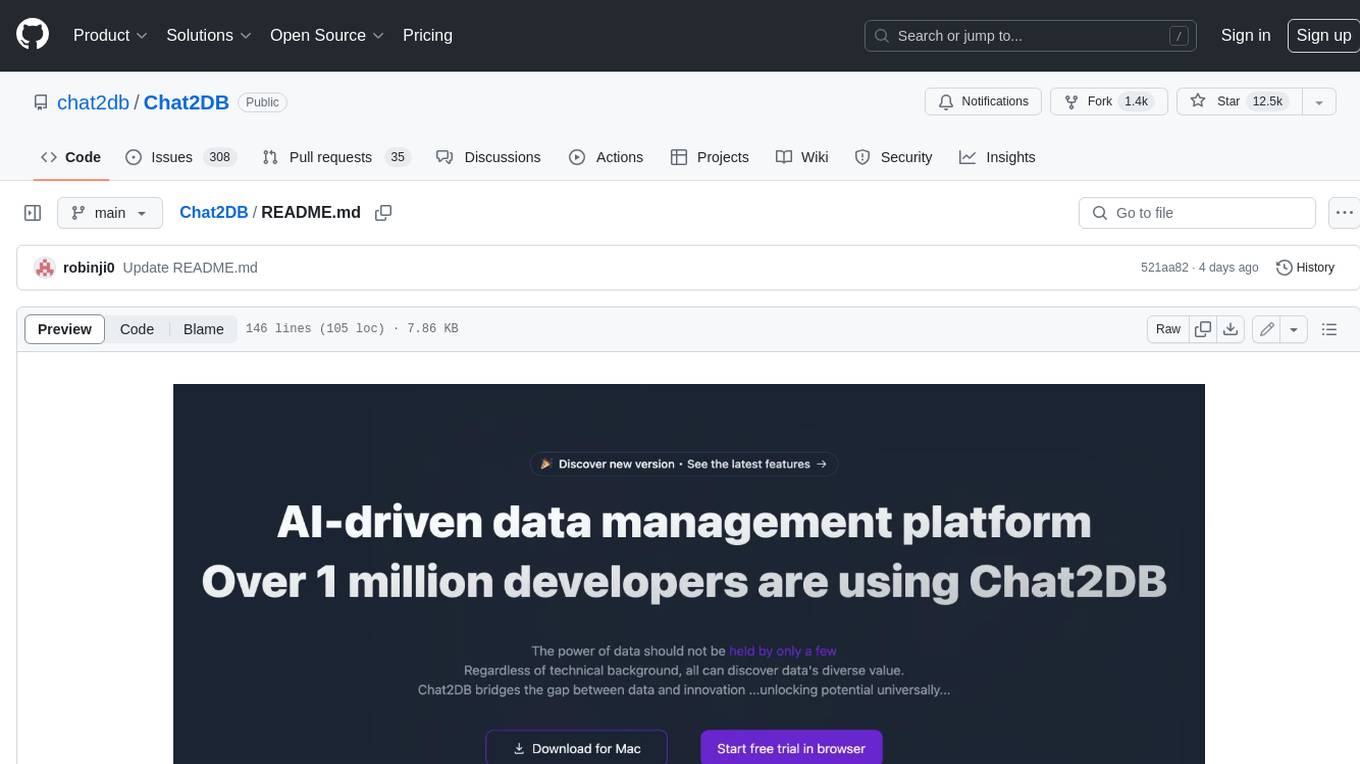
Chat2DB
Chat2DB is an AI-driven data development and analysis platform that enables users to communicate with databases using natural language. It supports a wide range of databases, including MySQL, PostgreSQL, Oracle, SQLServer, SQLite, MariaDB, ClickHouse, DM, Presto, DB2, OceanBase, Hive, KingBase, MongoDB, Redis, and Snowflake. Chat2DB provides a user-friendly interface that allows users to query databases, generate reports, and explore data using natural language commands. It also offers a variety of features to help users improve their productivity, such as auto-completion, syntax highlighting, and error checking.
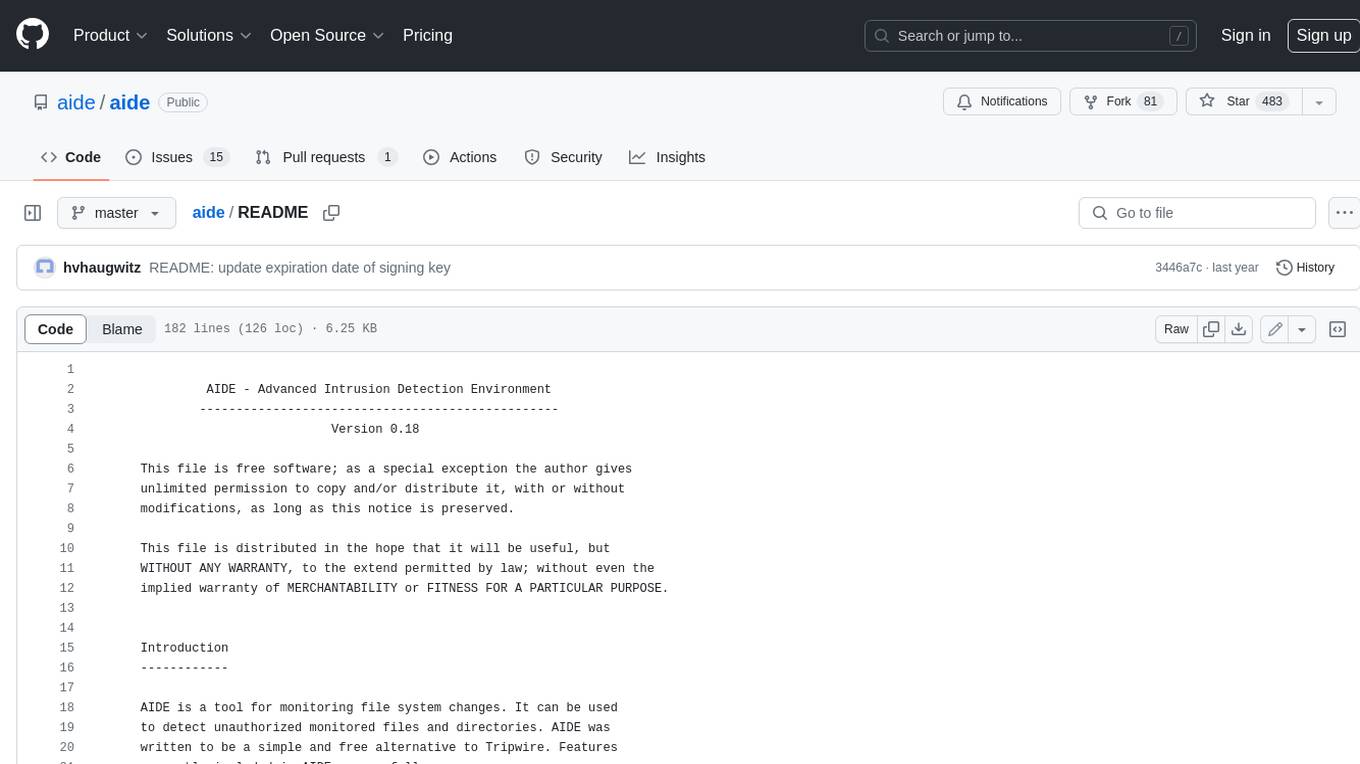
aide
AIDE (Advanced Intrusion Detection Environment) is a tool for monitoring file system changes. It can be used to detect unauthorized changes to monitored files and directories. AIDE was written to be a simple and free alternative to Tripwire. Features currently included in AIDE are as follows: o File attributes monitored: permissions, inode, user, group file size, mtime, atime, ctime, links and growing size. o Checksums and hashes supported: SHA1, MD5, RMD160, and TIGER. CRC32, HAVAL and GOST if Mhash support is compiled in. o Plain text configuration files and database for simplicity. o Rules, variables and macros that can be customized to local site or system policies. o Powerful regular expression support to selectively include or exclude files and directories to be monitored. o gzip database compression if zlib support is compiled in. o Free software licensed under the GNU General Public License v2.
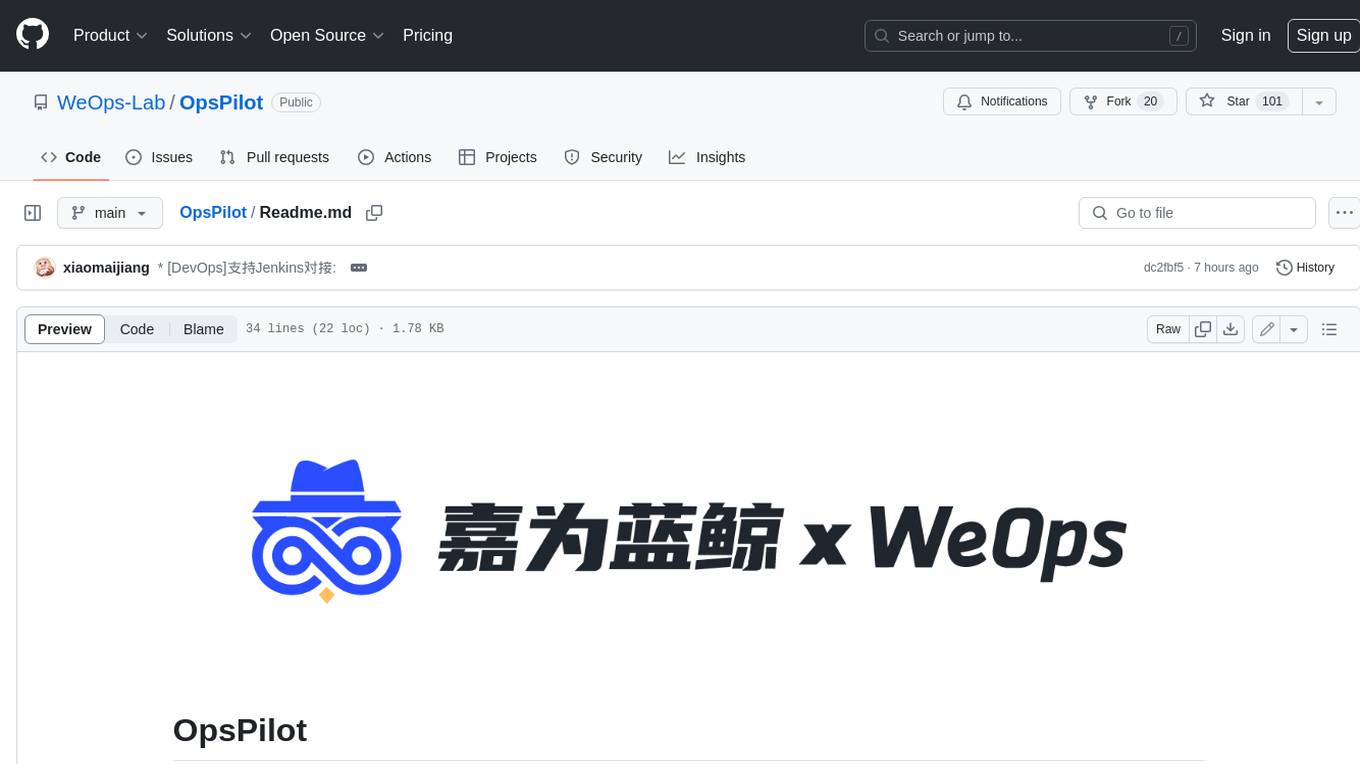
OpsPilot
OpsPilot is an AI-powered operations navigator developed by the WeOps team. It leverages deep learning and LLM technologies to make operations plans interactive and generalize and reason about local operations knowledge. OpsPilot can be integrated with web applications in the form of a chatbot and primarily provides the following capabilities: 1. Operations capability precipitation: By depositing operations knowledge, operations skills, and troubleshooting actions, when solving problems, it acts as a navigator and guides users to solve operations problems through dialogue. 2. Local knowledge Q&A: By indexing local knowledge and Internet knowledge and combining the capabilities of LLM, it answers users' various operations questions. 3. LLM chat: When the problem is beyond the scope of OpsPilot's ability to handle, it uses LLM's capabilities to solve various long-tail problems.
For similar jobs
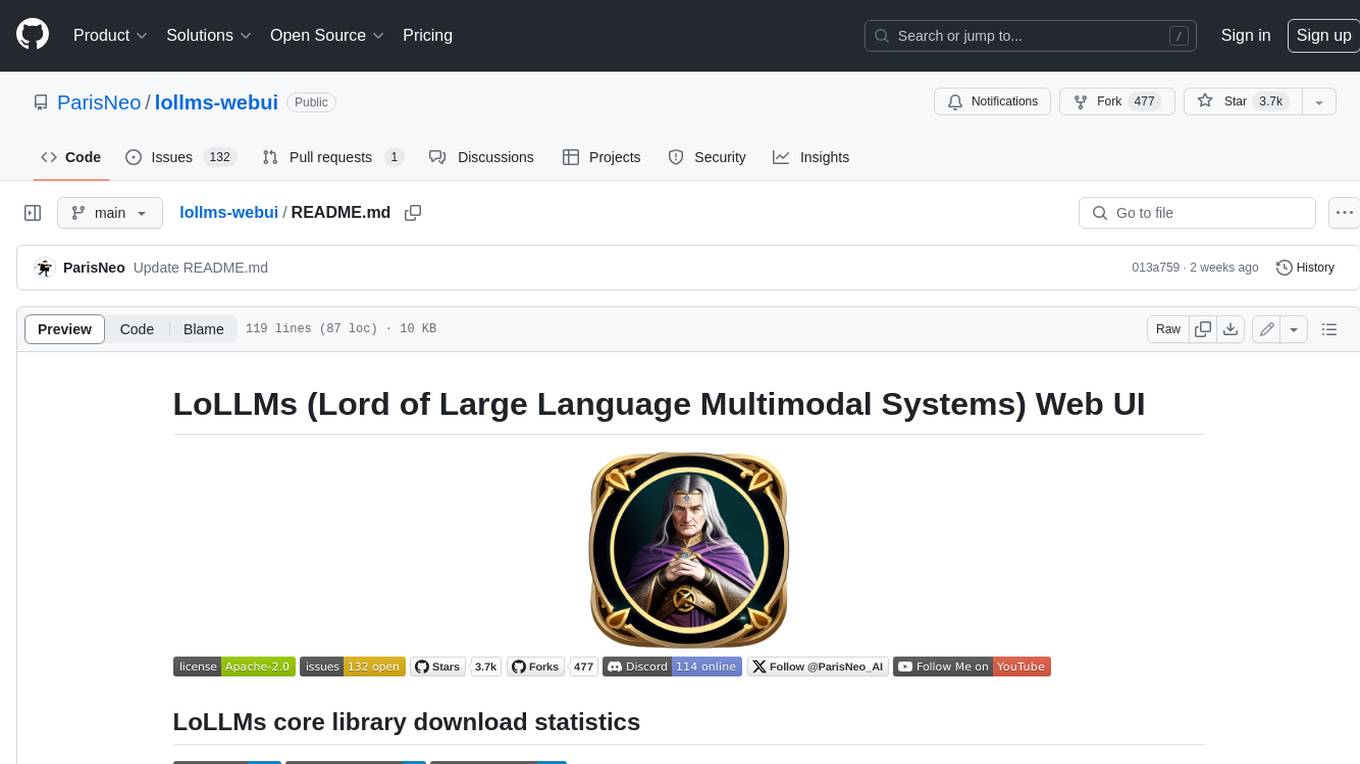
lollms-webui
LoLLMs WebUI (Lord of Large Language Multimodal Systems: One tool to rule them all) is a user-friendly interface to access and utilize various LLM (Large Language Models) and other AI models for a wide range of tasks. With over 500 AI expert conditionings across diverse domains and more than 2500 fine tuned models over multiple domains, LoLLMs WebUI provides an immediate resource for any problem, from car repair to coding assistance, legal matters, medical diagnosis, entertainment, and more. The easy-to-use UI with light and dark mode options, integration with GitHub repository, support for different personalities, and features like thumb up/down rating, copy, edit, and remove messages, local database storage, search, export, and delete multiple discussions, make LoLLMs WebUI a powerful and versatile tool.
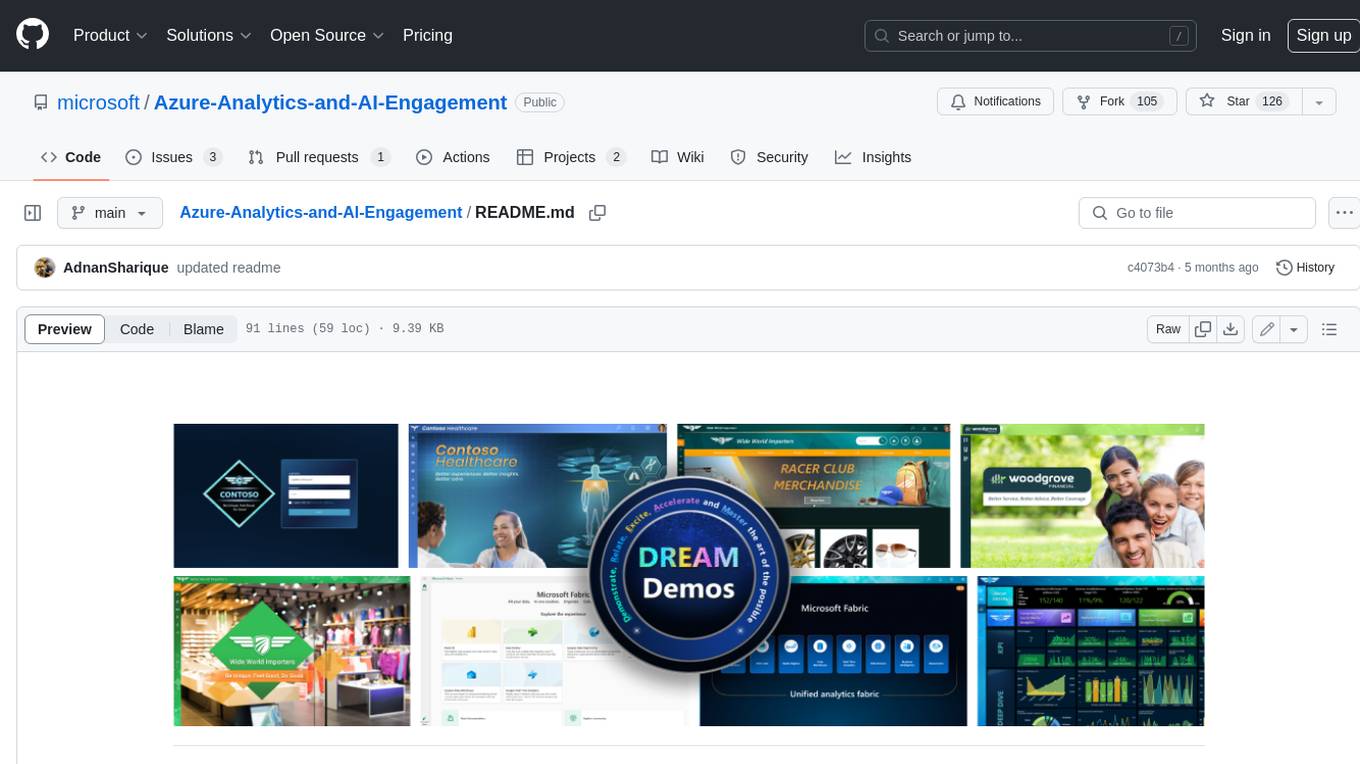
Azure-Analytics-and-AI-Engagement
The Azure-Analytics-and-AI-Engagement repository provides packaged Industry Scenario DREAM Demos with ARM templates (Containing a demo web application, Power BI reports, Synapse resources, AML Notebooks etc.) that can be deployed in a customer’s subscription using the CAPE tool within a matter of few hours. Partners can also deploy DREAM Demos in their own subscriptions using DPoC.
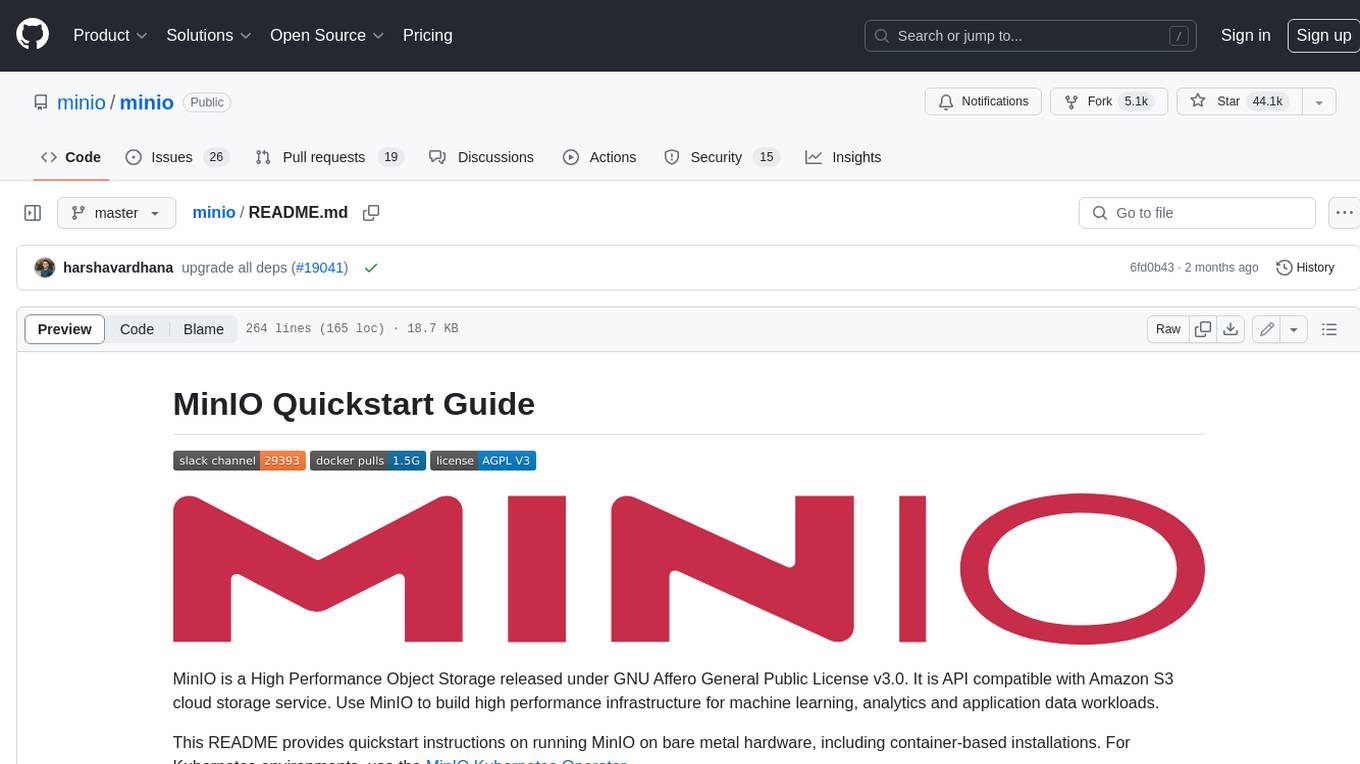
minio
MinIO is a High Performance Object Storage released under GNU Affero General Public License v3.0. It is API compatible with Amazon S3 cloud storage service. Use MinIO to build high performance infrastructure for machine learning, analytics and application data workloads.
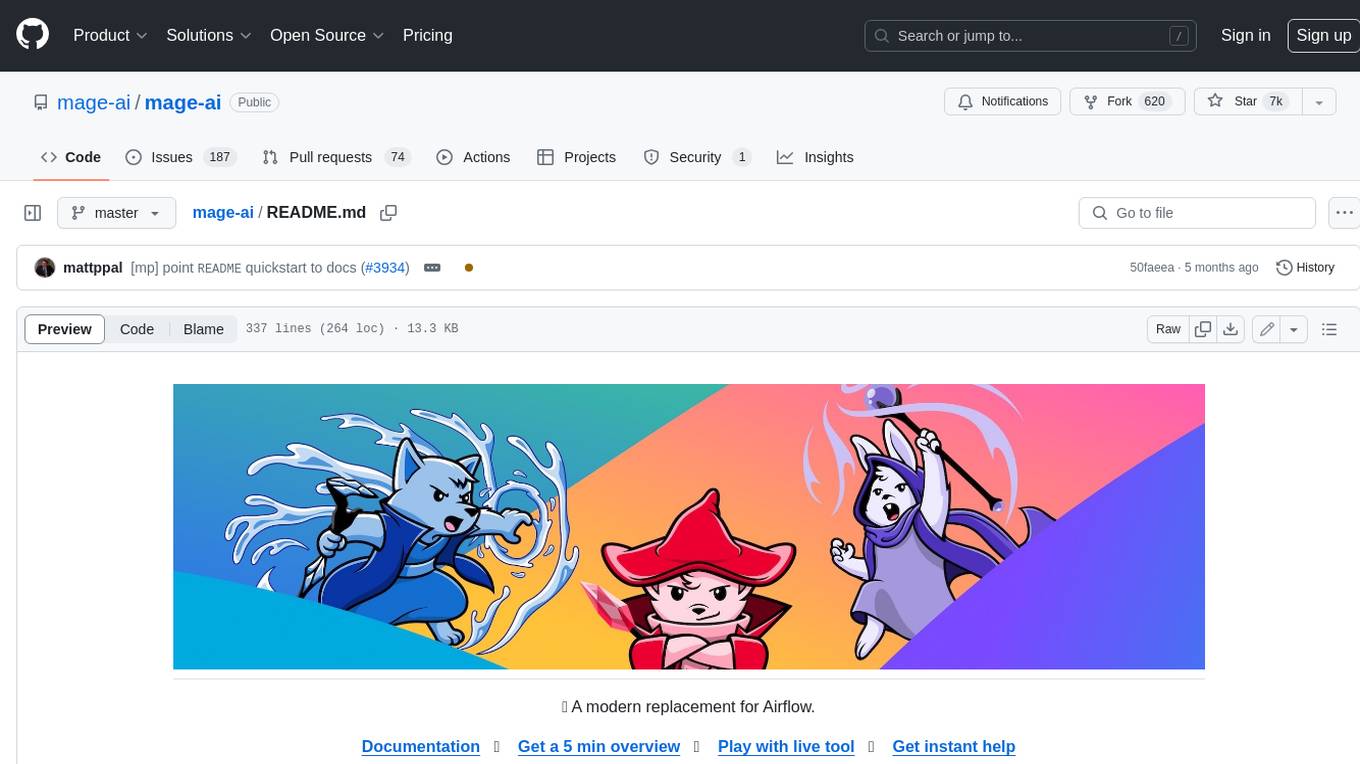
mage-ai
Mage is an open-source data pipeline tool for transforming and integrating data. It offers an easy developer experience, engineering best practices built-in, and data as a first-class citizen. Mage makes it easy to build, preview, and launch data pipelines, and provides observability and scaling capabilities. It supports data integrations, streaming pipelines, and dbt integration.
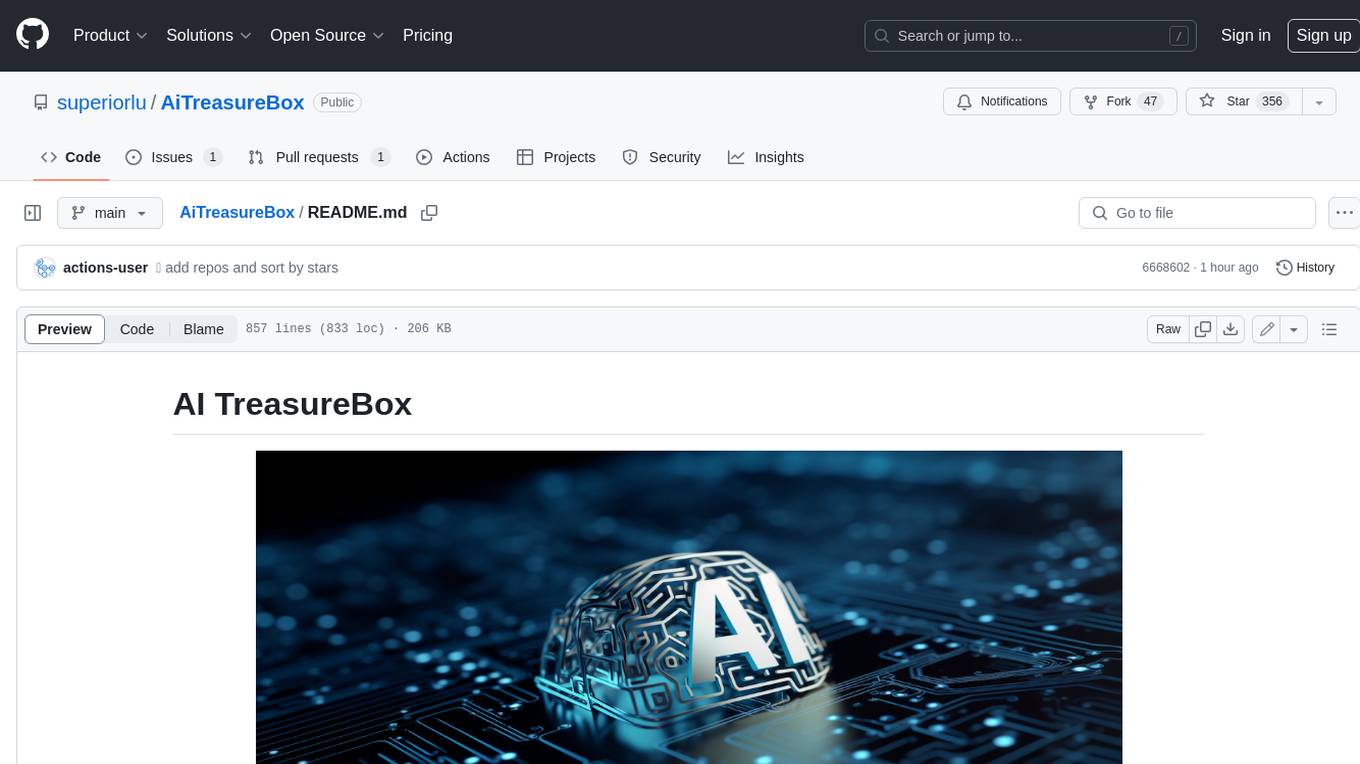
AiTreasureBox
AiTreasureBox is a versatile AI tool that provides a collection of pre-trained models and algorithms for various machine learning tasks. It simplifies the process of implementing AI solutions by offering ready-to-use components that can be easily integrated into projects. With AiTreasureBox, users can quickly prototype and deploy AI applications without the need for extensive knowledge in machine learning or deep learning. The tool covers a wide range of tasks such as image classification, text generation, sentiment analysis, object detection, and more. It is designed to be user-friendly and accessible to both beginners and experienced developers, making AI development more efficient and accessible to a wider audience.
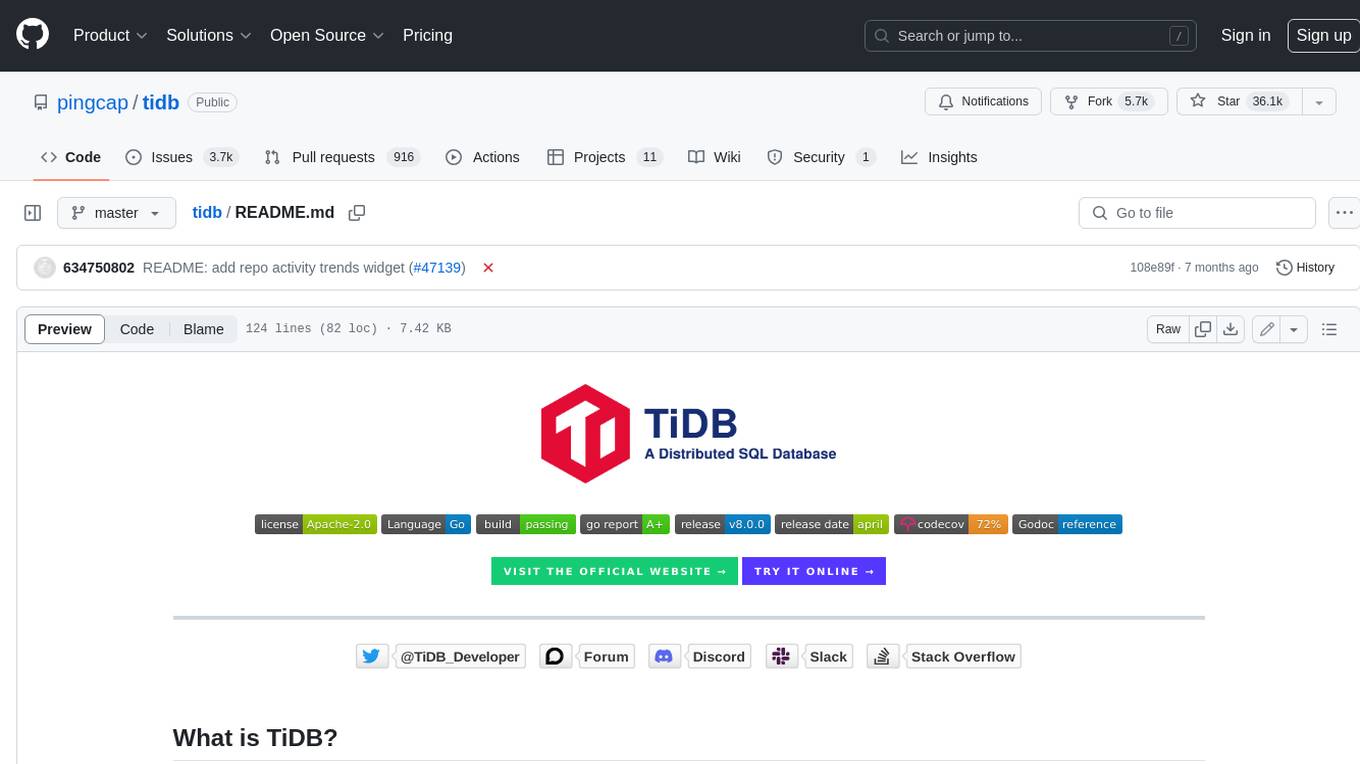
tidb
TiDB is an open-source distributed SQL database that supports Hybrid Transactional and Analytical Processing (HTAP) workloads. It is MySQL compatible and features horizontal scalability, strong consistency, and high availability.
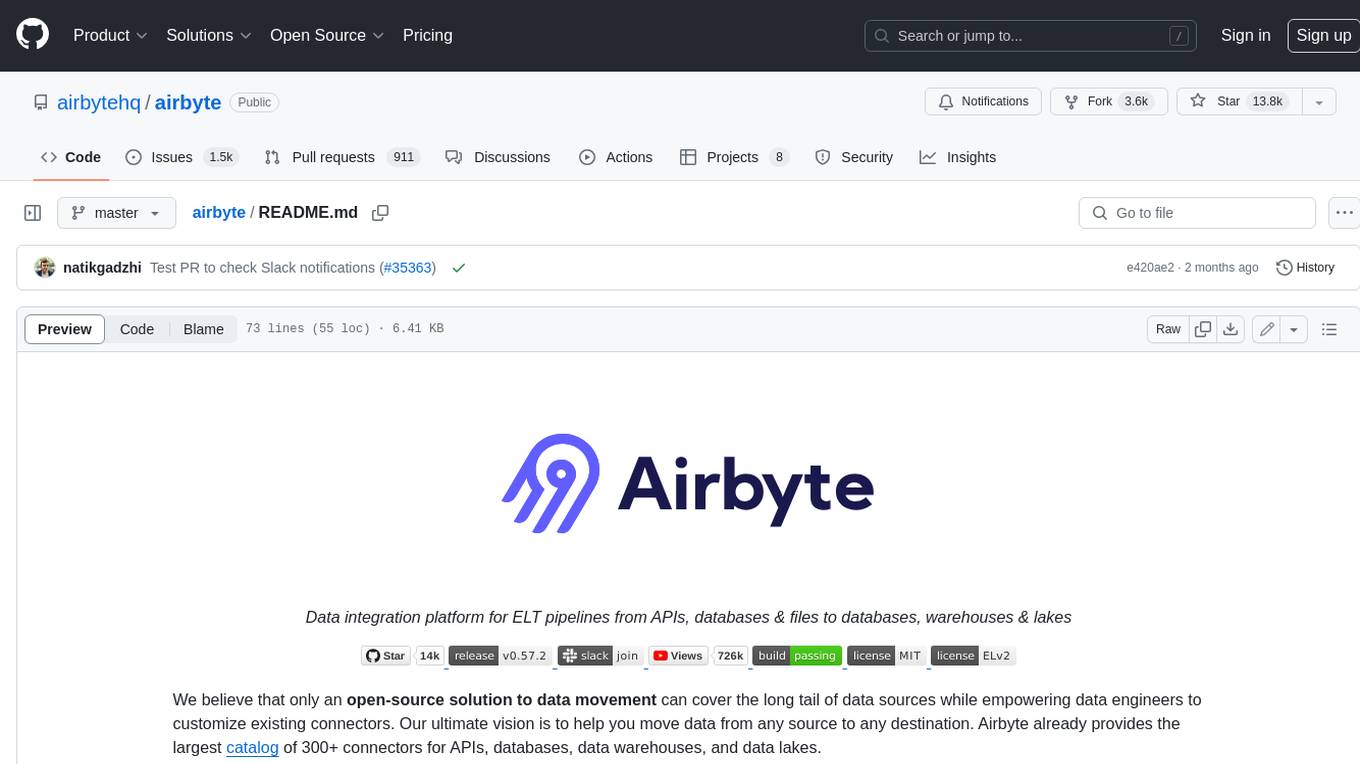
airbyte
Airbyte is an open-source data integration platform that makes it easy to move data from any source to any destination. With Airbyte, you can build and manage data pipelines without writing any code. Airbyte provides a library of pre-built connectors that make it easy to connect to popular data sources and destinations. You can also create your own connectors using Airbyte's no-code Connector Builder or low-code CDK. Airbyte is used by data engineers and analysts at companies of all sizes to build and manage their data pipelines.
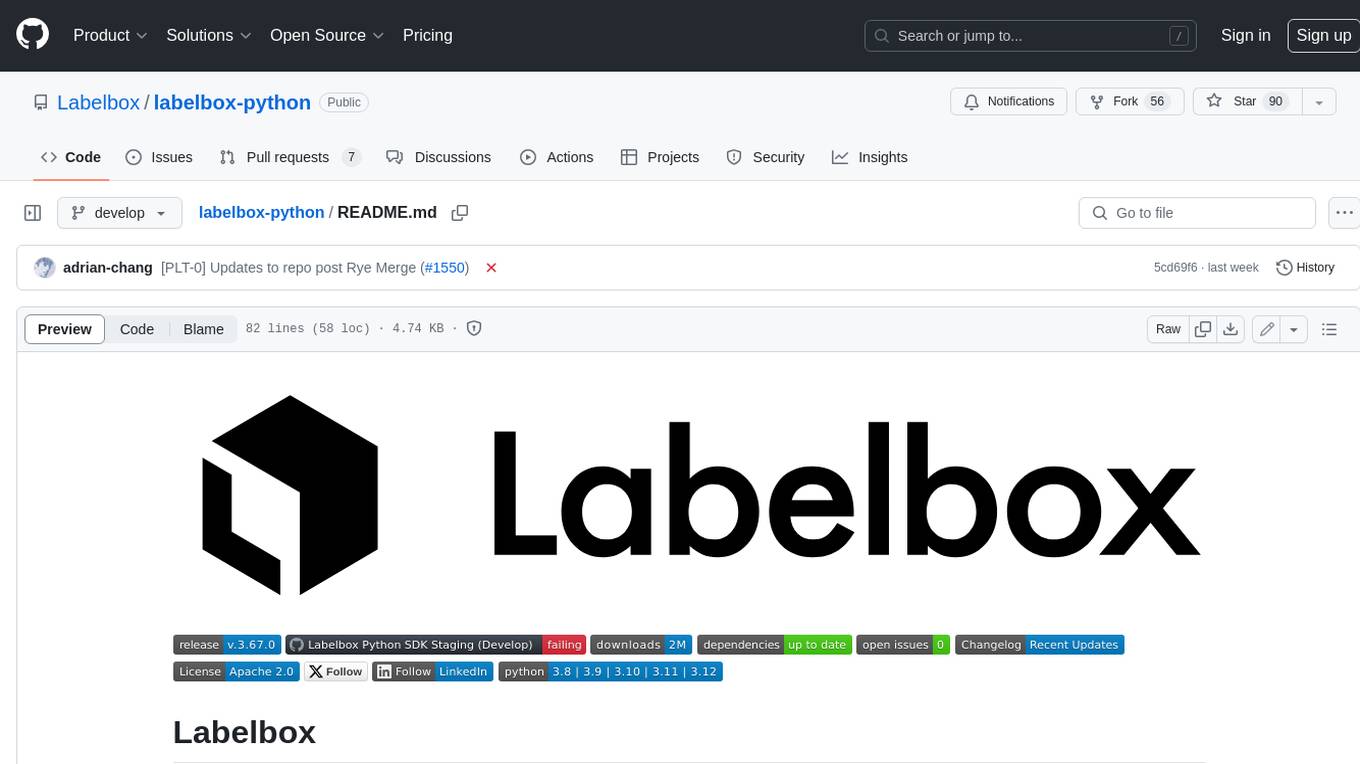
labelbox-python
Labelbox is a data-centric AI platform for enterprises to develop, optimize, and use AI to solve problems and power new products and services. Enterprises use Labelbox to curate data, generate high-quality human feedback data for computer vision and LLMs, evaluate model performance, and automate tasks by combining AI and human-centric workflows. The academic & research community uses Labelbox for cutting-edge AI research.


















